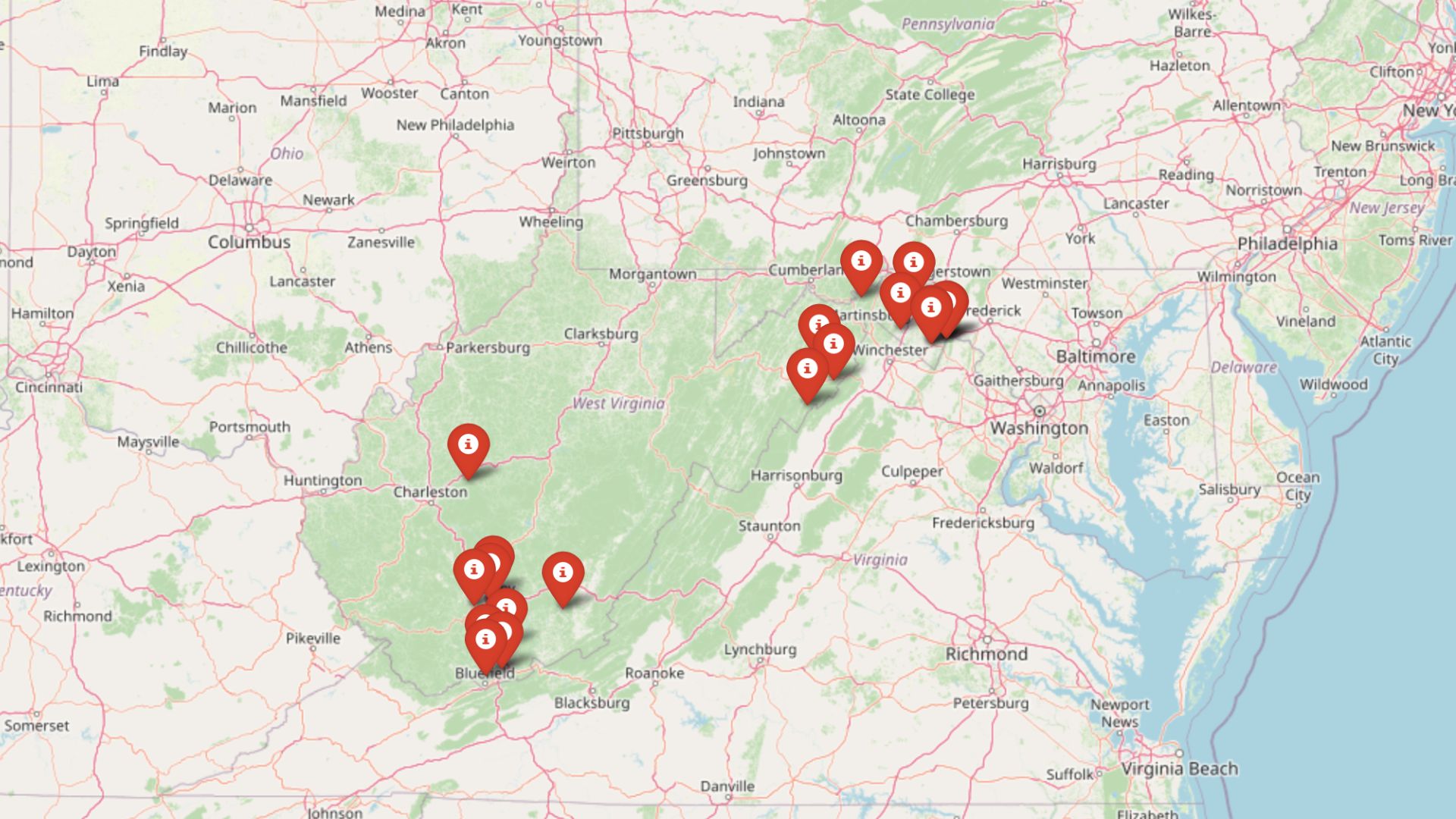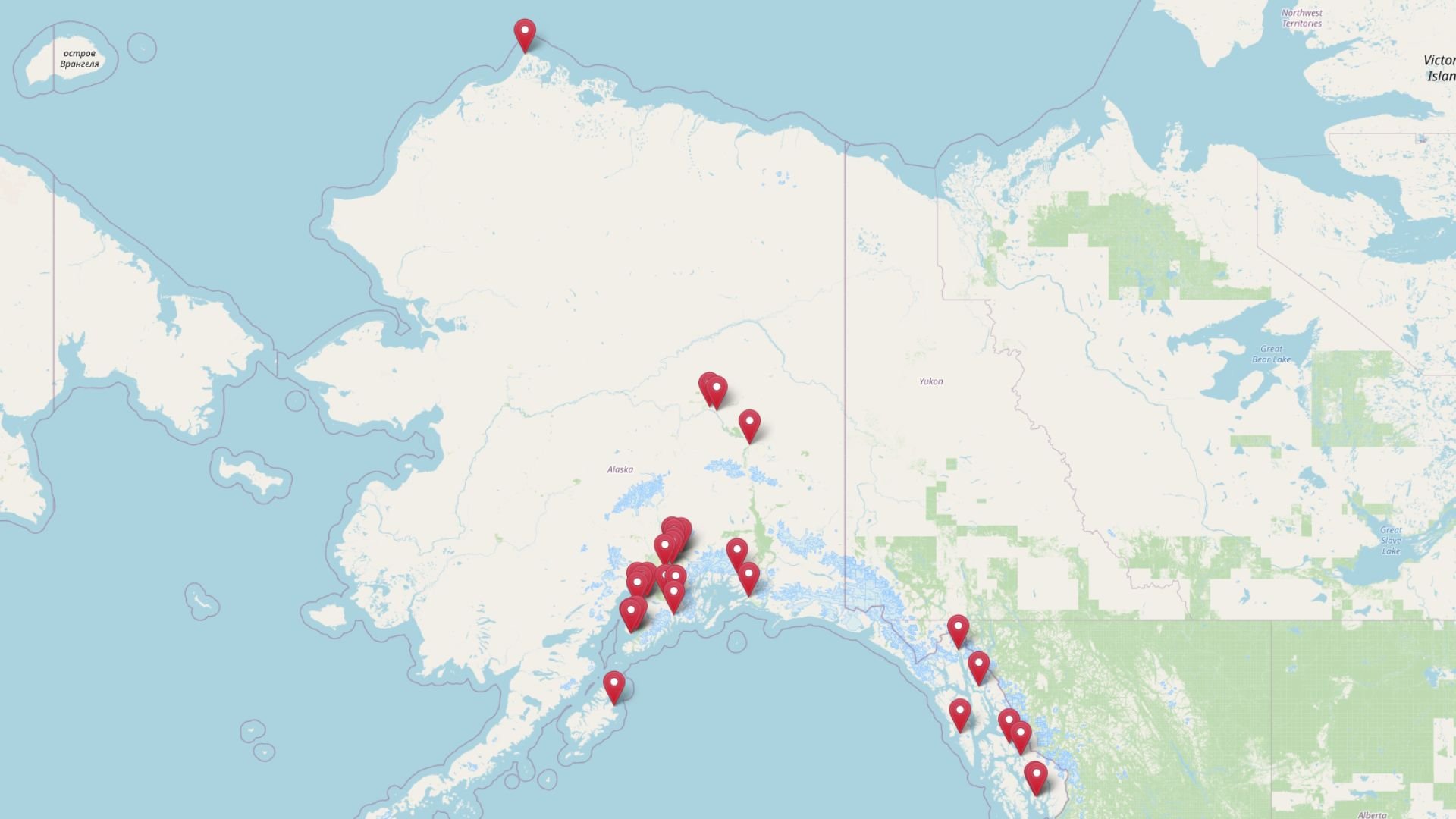
Alaska’s housing market has shown remarkable resilience and growth patterns, with home values climbing steadily across the state. The latest Zillow Home Value Index data reveals 30 towns where property values have reached impressive heights, ranging from small fishing communities to suburban enclaves near major cities. These communities represent the pinnacle of Alaska’s real estate market, where natural beauty meets serious investment potential.
From remote coastal settlements accessible only by boat or plane to thriving suburbs within commuting distance of Anchorage, each town on this list has carved out its own niche in Alaska’s diverse housing landscape. The data shows price increases spanning from modest 2% gains to explosive 98% jumps over various time periods, reflecting the unique economic forces and desirability factors that drive demand in America’s largest state.
30. Moose Pass – 78% Home Price Increase Since 2012
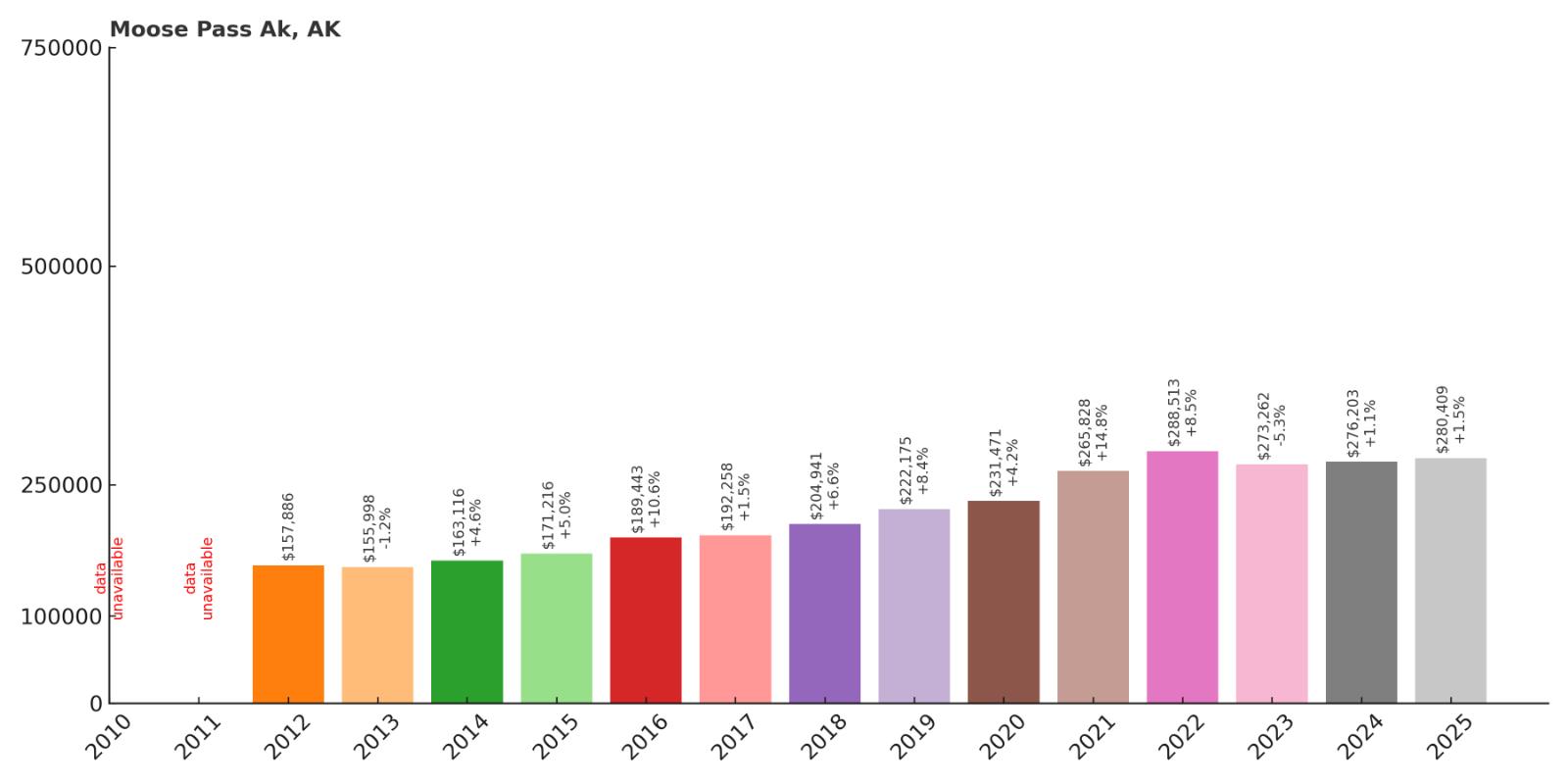
- 2010: N/A
- 2011: N/A
- 2012: $157,886
- 2013: $155,998
- 2014: $163,116
- 2015: $171,216
- 2016: $189,443
- 2017: $192,258
- 2018: $204,941
- 2019: $222,175
- 2020: $231,471
- 2021: $265,828
- 2022: $288,513
- 2023: $273,262
- 2024: $276,203
- 2025: $280,409
Moose Pass has demonstrated steady appreciation since data became available in 2012, with median home values climbing from under $158,000 to over $280,000. The town experienced its strongest growth during the pandemic housing boom of 2020-2022, adding nearly $57,000 in value. Current prices reflect a stabilization after the 2022 peak, with modest gains continuing into 2025.
Why Moose Pass?

Why are people willing to pay so much to live here? What’s special about it?
Moose Pass attracts buyers seeking a quintessential Alaskan experience without complete isolation from amenities. The town sits along the scenic Seward Highway on the Kenai Peninsula, offering stunning mountain and lake views. Residents enjoy year-round outdoor recreation including fishing, hiking, and wildlife viewing right from their doorsteps.
The community maintains a rural character while staying connected to larger towns like Seward and Anchorage via reliable highway access. Properties often feature larger lots and custom-built homes that take advantage of the natural setting. Limited development and protected wilderness areas help maintain property values and the area’s pristine appeal.
How Moose Pass Rose to Prominence
Moose Pass began as a railroad construction camp in the early 1900s during the building of the Alaska Railroad. The town’s name comes from a narrow mountain pass where moose would cross between valleys, creating a natural bottleneck that early settlers recognized as strategically important. For decades, it served primarily as a supply depot and rest stop for travelers and railroad workers.
The completion of the Seward Highway in the 1950s transformed Moose Pass from an isolated railroad town into an accessible mountain community. Tourism growth along the Kenai Peninsula in the 1980s and 1990s brought new residents seeking second homes and retirement properties. Recent decades have seen steady development as remote work options and Alaska’s natural appeal draw year-round residents.
3 Interesting Tidbits
1. Trail Lake Connection – The town sits on the shores of Trail Lake, a pristine glacial lake that provides some of the best freshwater fishing in southcentral Alaska.
2. Railroad Heritage – Moose Pass remains one of the few communities along the Alaska Railroad route where the historic depot building still stands and operates.
3. Summer Festival – The annual Moose Pass Summer Festival draws visitors from across Alaska for its small-town charm and traditional Alaskan celebration of the brief but intense summer season.
29. Kasilof – 66% Home Price Increase Since 2010
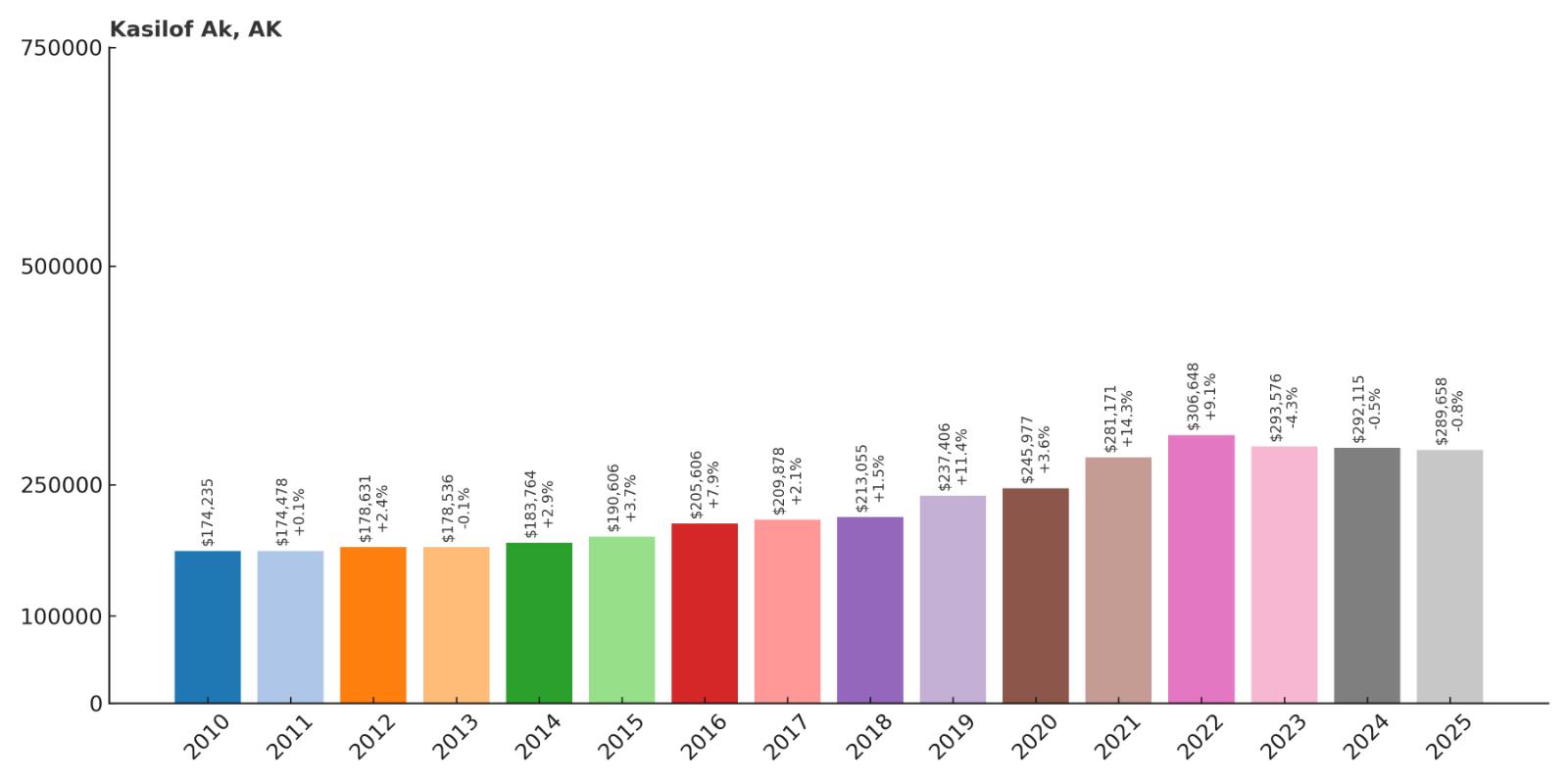
- 2010: $174,235
- 2011: $174,478
- 2012: $178,631
- 2013: $178,536
- 2014: $183,764
- 2015: $190,606
- 2016: $205,606
- 2017: $209,878
- 2018: $213,055
- 2019: $237,406
- 2020: $245,977
- 2021: $281,171
- 2022: $306,648
- 2023: $293,576
- 2024: $292,115
- 2025: $289,658
Kasilof has shown consistent growth over 15 years, with home values increasing from $174,235 to nearly $290,000. The community experienced particularly strong gains from 2019-2022, adding over $69,000 in median value during this period. Recent years have seen some cooling from peak prices but values remain well above historical levels.
Why Kasilof?

Why are people willing to pay so much to live here? What’s special about it?
Kasilof offers prime access to world-class salmon fishing on the Kasilof River, one of Alaska’s most productive fisheries. The community combines rural living with reasonable access to services in nearby Soldotna and Kenai. Residents can enjoy subsistence fishing rights and hunting opportunities while maintaining connections to larger communities.
The area features a mix of riverfront properties, large residential lots, and agricultural land that appeals to those seeking self-sufficient lifestyles. Many homes are custom-built to take advantage of river views and outdoor recreation access. The stable year-round population and growing reputation as a fishing destination help support property values.
How Kasilof Rose to Prominence
Kasilof’s roots trace back to Russian fur trading posts established in the early 1800s along the strategic Kasilof River. Native Dena’ina people had used the area for centuries as a seasonal fishing camp, taking advantage of the abundant salmon runs. The name “Kasilof” comes from the Dena’ina word meaning “place where we wait for fish.”
American settlement accelerated after the 1867 Alaska Purchase, with homesteaders attracted by fertile soil and fishing opportunities. The area developed as an agricultural center in the early 1900s, with dairy farms and potato cultivation supporting the growing population. Modern Kasilof emerged in the mid-20th century as sport fishing and tourism brought new economic opportunities and seasonal residents who eventually became permanent community members.
3 Interesting Tidbits
1. Prehistoric Village – Archaeological evidence shows the Kasilof River area has been continuously inhabited for over 2,000 years, making it one of Alaska’s oldest settlement sites.
2. Agricultural Legacy – Kasilof was home to some of Alaska’s first successful potato farms, with the rich river delta soil producing crops that fed much of the Kenai Peninsula.
3. Fishing Paradise – The Kasilof River produces some of Alaska’s largest king salmon, with fish over 50 pounds caught regularly during peak season runs.
28. Saxman – 62% Home Price Increase Since 2012
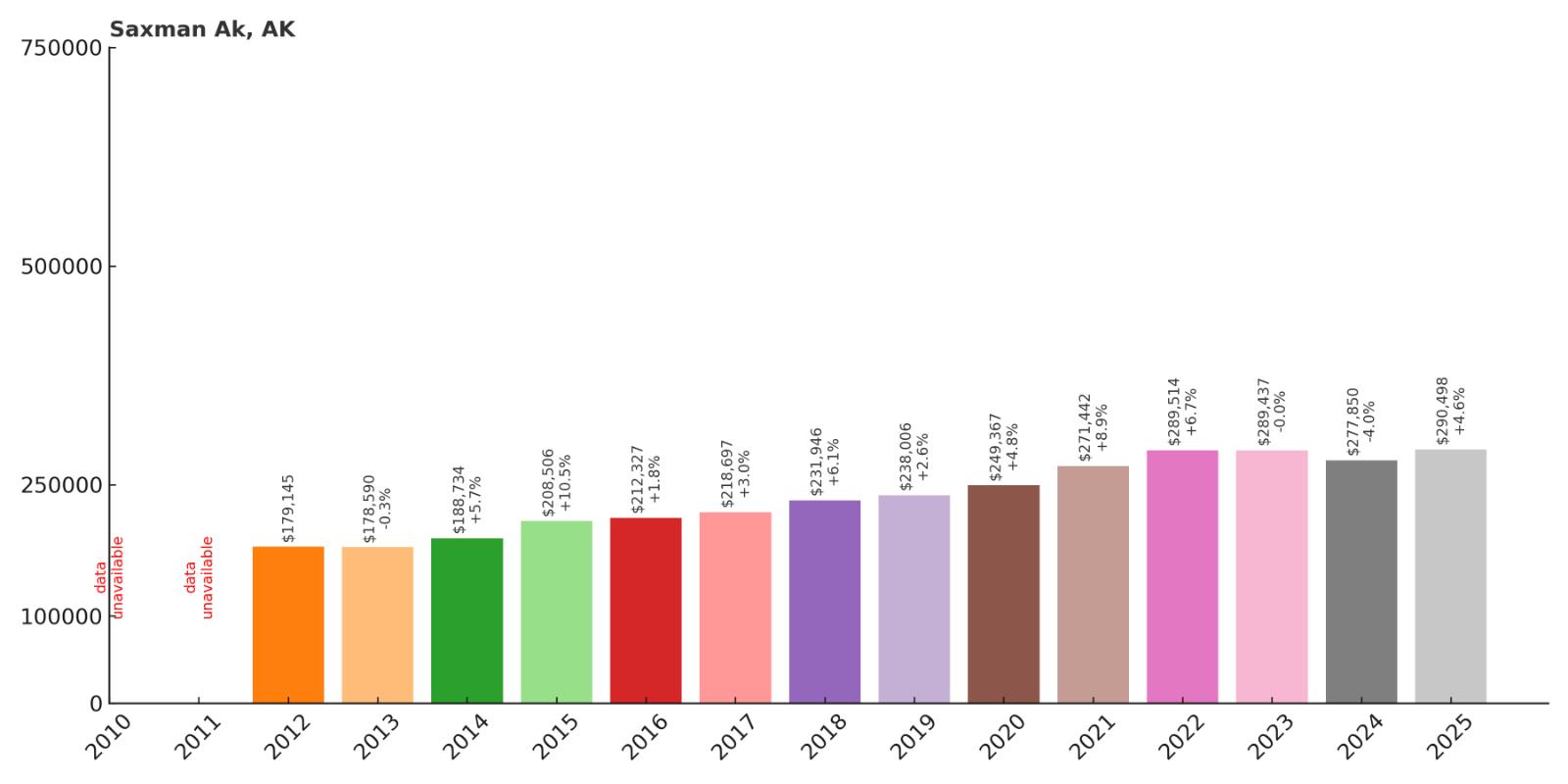
- 2010: N/A
- 2011: N/A
- 2012: $179,145
- 2013: $178,590
- 2014: $188,734
- 2015: $208,506
- 2016: $212,327
- 2017: $218,697
- 2018: $231,946
- 2019: $238,006
- 2020: $249,367
- 2021: $271,442
- 2022: $289,514
- 2023: $289,437
- 2024: $277,850
- 2025: $290,498
Saxman has achieved steady appreciation since 2012, with home values rising from under $180,000 to over $290,000. The community saw consistent growth through the 2010s, with acceleration during the pandemic housing boom of 2020-2022. After a brief correction in 2024, values have rebounded to new highs in 2025.
Why Saxman?

Why are people willing to pay so much to live here? What’s special about it?
Saxman offers unique cultural significance as an Alaska Native village just minutes from Ketchikan’s amenities. The community is renowned for its exceptional collection of totem poles and traditional Tlingit cultural sites. Residents enjoy the benefits of small-town living while having easy access to Ketchikan’s services, employment, and transportation connections.
The village maintains strong traditional values and community connections while offering modern conveniences and infrastructure. Properties often feature views of the Inside Passage and surrounding temperate rainforest. The combination of cultural heritage, natural beauty, and proximity to Ketchikan creates a distinctive living environment found nowhere else in Alaska.
How Saxman Rose to Prominence
Saxman was established in 1894 when Tlingit families from the Cape Fox and Tongass villages relocated to be closer to Ketchikan’s economic opportunities. The village was named after Samuel Saxman, a Tlingit leader who advocated for the move and worked to preserve traditional culture while adapting to changing times. Early residents combined traditional subsistence activities with wage labor in Ketchikan’s growing fishing and timber industries.
The community became famous for its totem pole restoration projects beginning in the 1930s, when Civilian Conservation Corps workers helped move and restore historic poles from abandoned village sites. This cultural preservation effort attracted attention and tourism, establishing Saxman as a premier destination for experiencing authentic Alaska Native culture. Modern development has balanced growth with cultural preservation, creating a unique community that honors its heritage while providing contemporary amenities.
3 Interesting Tidbits
1. Totem Pole Capital – Saxman houses the world’s largest collection of standing totem poles, with over 30 historic and contemporary poles displayed throughout the village.
2. Cultural Center – The Saxman Native Village offers traditional carving demonstrations and cultural performances, making it a premier destination for cultural tourism in Southeast Alaska.
3. Clan House Tradition – The village maintains an active clan house where traditional ceremonies and community gatherings continue to follow ancestral Tlingit customs.
27. Fairbanks – 32% Home Price Increase Since 2010
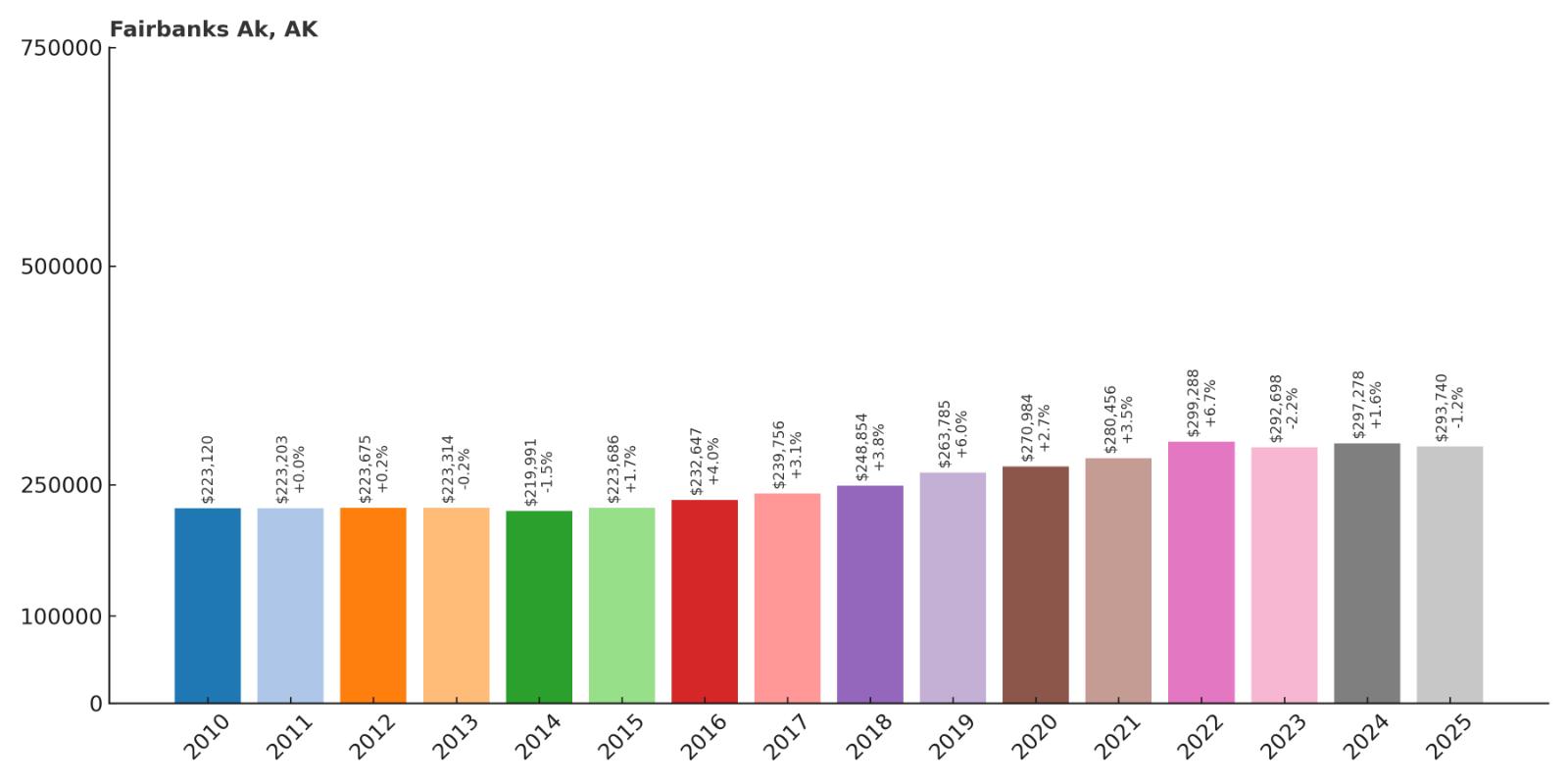
- 2010: $223,120
- 2011: $223,203
- 2012: $223,675
- 2013: $223,314
- 2014: $219,991
- 2015: $223,686
- 2016: $232,647
- 2017: $239,756
- 2018: $248,854
- 2019: $263,785
- 2020: $270,984
- 2021: $280,456
- 2022: $299,288
- 2023: $292,698
- 2024: $297,278
- 2025: $293,740
Fairbanks has shown modest but steady growth over 15 years, with median home values increasing from around $223,000 to nearly $294,000. The city experienced relatively stable pricing through the early 2010s before accelerating in the late 2010s and pandemic period. Current values reflect some cooling from 2022 peaks but remain significantly above historical levels.
Why Fairbanks?

Why are people willing to pay so much to live here? What’s special about it?
Fairbanks serves as Alaska’s second-largest city and the economic hub of the state’s interior region. The city offers urban amenities including the University of Alaska Fairbanks, diverse employment opportunities, and cultural attractions uncommon elsewhere in Alaska. Residents enjoy access to world-class aurora viewing, dog mushing culture, and vast wilderness areas for outdoor recreation.
The community provides four-season living with extreme but manageable winter conditions and warm, sunny summers. Military installations and government employment offer stable economic foundations alongside university research and tourism industries. Properties range from urban neighborhoods to large lots on the city’s outskirts, accommodating diverse lifestyle preferences.
How Fairbanks Rose to Prominence
Fairbanks was founded in 1901 as a trading post by E.T. Barnette, who was stranded on the Chena River when his steamboat couldn’t continue upstream. The discovery of gold in the nearby hills in 1902 transformed the trading post into a booming mining town virtually overnight. Named after Charles Fairbanks, who later became Vice President under Theodore Roosevelt, the city became the commercial center for Interior Alaska’s gold mining operations.
World War II brought massive military construction and established Fairbanks as a strategic military location, with facilities that remain crucial today. The University of Alaska was founded here in 1917, growing into a major research institution focused on Arctic studies and natural resources. Modern Fairbanks balances its roles as a military hub, university town, and gateway to Arctic Alaska, creating a diverse economy that supports its position as Interior Alaska’s primary city.
3 Interesting Tidbits
1. Aurora Capital – Fairbanks sits directly under the auroral oval, making it one of the world’s best places to view the northern lights with over 240 nights per year of potential aurora activity.
2. Midnight Sun Baseball – The Alaska Goldpanners play their annual midnight game each summer solstice without artificial lights, continuing a tradition that began in 1906.
3. Ice Art World – The city hosts the World Ice Art Championships each spring, where artists create massive sculptures from blocks of crystal-clear Fairbanks ice.
26. Barrow – 98% Home Price Increase Since 2016
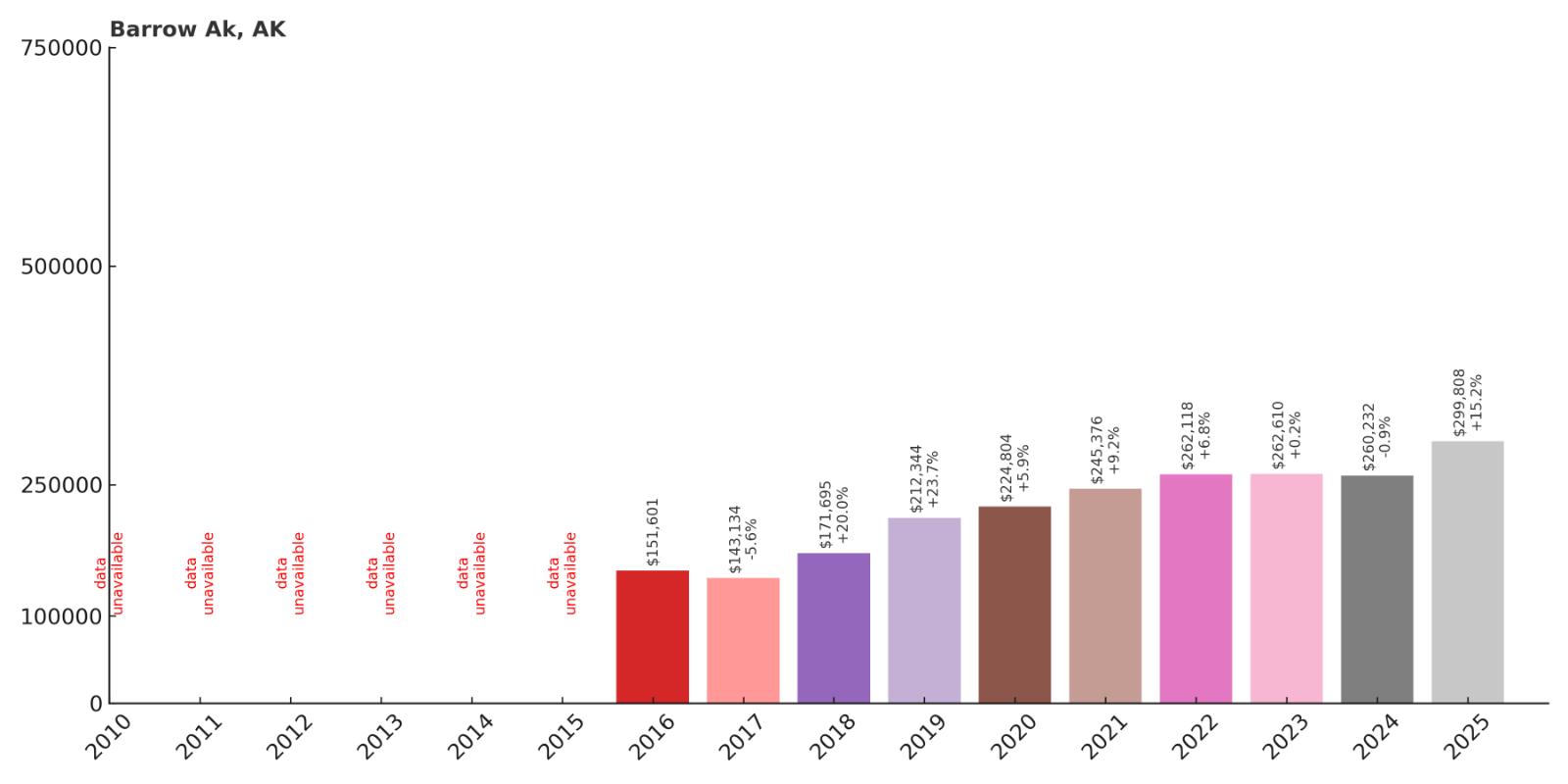
- 2010: N/A
- 2011: N/A
- 2012: N/A
- 2013: N/A
- 2014: N/A
- 2015: N/A
- 2016: $151,601
- 2017: $143,134
- 2018: $171,695
- 2019: $212,344
- 2020: $224,804
- 2021: $245,376
- 2022: $262,118
- 2023: $262,610
- 2024: $260,232
- 2025: $299,808
Barrow has experienced explosive growth since 2016, with home values nearly doubling from around $152,000 to nearly $300,000. The community saw particularly dramatic gains from 2017-2019, adding over $69,000 in value during this period. After some stabilization through 2024, values surged again in 2025 to reach new record highs.
Why Barrow?

Why are people willing to pay so much to live here? What’s special about it?
Barrow (officially Utqiagvik) represents America’s northernmost community, offering a unique Arctic living experience found nowhere else in the United States. The town provides essential services and employment opportunities for residents engaged in subsistence activities, oil industry work, and government positions. Limited housing supply and extreme transportation costs contribute to premium pricing for available properties.
Residents experience traditional Inupiat culture alongside modern amenities, with access to subsistence hunting and fishing rights that significantly supplement household economies. The community offers stability and infrastructure in one of Earth’s most challenging environments. Properties must meet specialized construction standards for permafrost and extreme weather, making each home a significant investment in Arctic engineering.
How Barrow Rose to Prominence
Barrow has been continuously inhabited by Inupiat people for over 1,500 years, making it one of the oldest permanent settlements in North America. The community’s location at the northernmost point of Alaska made it a crucial whaling center, where Inupiat hunters developed sophisticated techniques for hunting bowhead whales that continue today. European contact began in the 1800s with whaling ships, but the community maintained its traditional governance and cultural practices.
The discovery of oil at nearby Prudhoe Bay in 1968 transformed Barrow into a regional hub for Arctic oil operations. The Alaska Native Claims Settlement Act of 1971 established the Arctic Slope Regional Corporation, headquartered in Barrow, making it one of Alaska’s most economically powerful Native corporations. Modern Barrow balances its role as a center for traditional Inupiat culture with its position as the administrative and logistical hub for Arctic Alaska’s oil industry.
3 Interesting Tidbits
1. Polar Night and Midnight Sun – Barrow experiences 65 days of total darkness in winter and 65 days of continuous daylight in summer, representing the most extreme seasonal light variations in the United States.
2. Ancient Whaling Tradition – The community continues a 1,500-year-old bowhead whale hunting tradition that provides essential nutrition and maintains crucial cultural connections for Inupiat families.
3. Permafrost Foundation – All buildings in Barrow must be constructed on pilings or special foundations to prevent melting the permafrost beneath, creating unique architectural challenges and solutions.
25. Wrangell – 44% Home Price Increase Since 2016
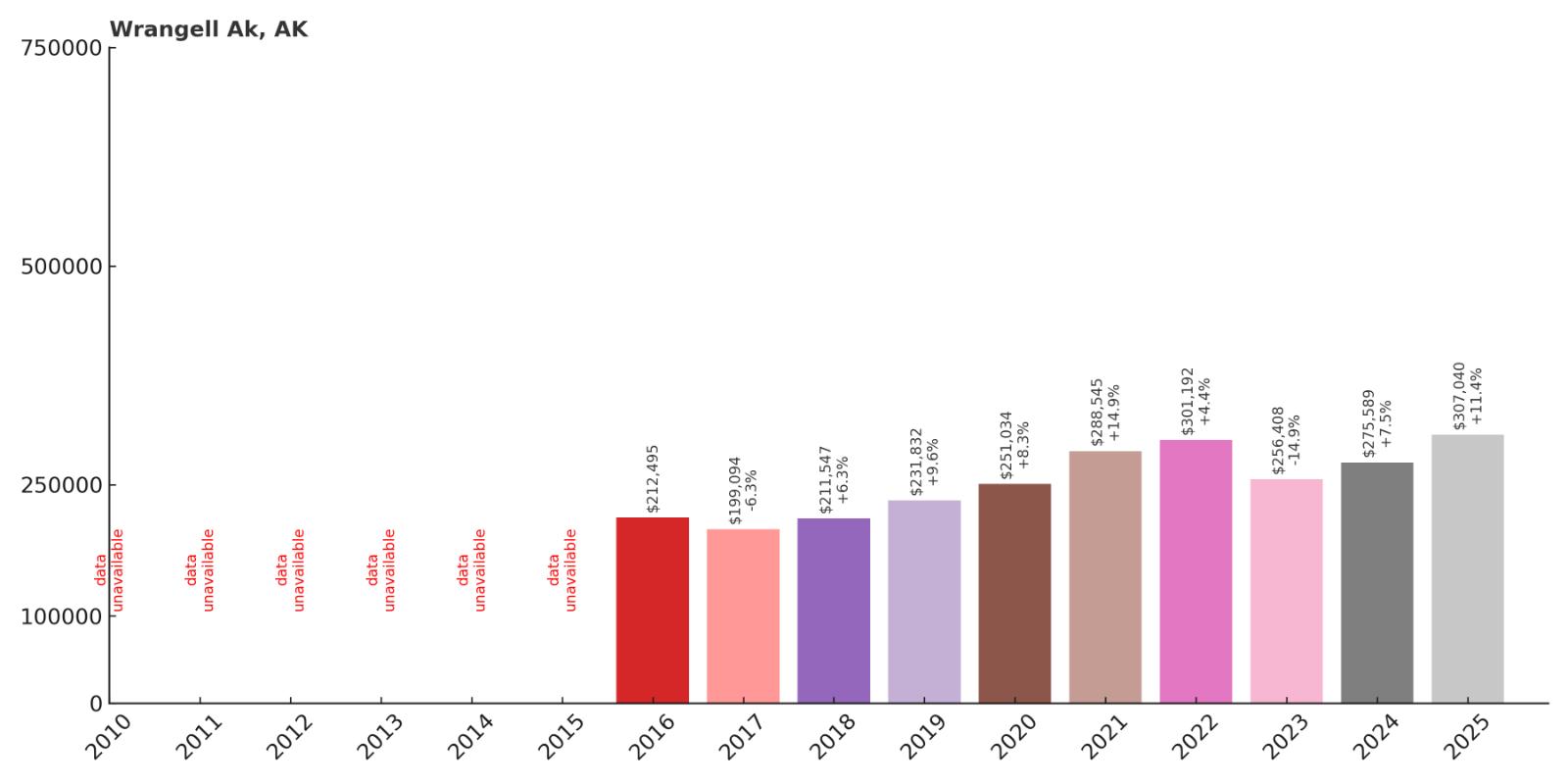
- 2010: N/A
- 2011: N/A
- 2012: N/A
- 2013: N/A
- 2014: N/A
- 2015: N/A
- 2016: $212,495
- 2017: $199,094
- 2018: $211,547
- 2019: $231,832
- 2020: $251,034
- 2021: $288,545
- 2022: $301,192
- 2023: $256,408
- 2024: $275,589
- 2025: $307,040
Wrangell has demonstrated significant appreciation since 2016, with values climbing from around $212,000 to over $307,000. The community experienced strong growth from 2019-2022, adding nearly $70,000 in median value. After a notable dip in 2023, values have rebounded strongly over the past two years to reach new highs.
Why Wrangell?

Why are people willing to pay so much to live here? What’s special about it?
Wrangell offers island living in Southeast Alaska with access to some of the region’s best fishing, hunting, and outdoor recreation opportunities. The community maintains a strong local economy based on fishing, timber, and tourism while preserving its small-town character and tight-knit community bonds. Limited housing supply on the island creates premium pricing for available properties.
Residents enjoy year-round temperate climate, stunning natural scenery, and easy access to wilderness areas and marine environments. The town provides essential services and infrastructure while maintaining the independence and self-reliance that attracts many Alaska residents. Properties often feature waterfront access and views of the surrounding mountains and islands.
How Wrangell Rose to Prominence
Wrangell has the distinction of being governed under four different flags – Tlingit, Russian, British, and American – reflecting its strategic location in Southeast Alaska. Originally a Tlingit settlement called Shtax’heen, the site controlled important trade routes between coastal and interior regions. Russians established a fort here in 1834, naming it Redoubt Saint Dionysius, which the British later renamed Fort Stikine.
The American period began with the 1867 Alaska Purchase, and the town was renamed Wrangell after Baron Ferdinand von Wrangel, a Russian admiral. Gold discoveries in nearby areas during the 1860s and 1890s made Wrangell a crucial supply point for miners heading to Canadian goldfields. The community developed around fishing, logging, and maritime industries, establishing itself as a regional center that balanced economic development with cultural preservation.
3 Interesting Tidbits
1. Four Flags Heritage – Wrangell is the only city in Alaska to have been governed under four different national flags, representing its complex history as a strategic trading location.
2. Petroglyph Beach – The town features one of Southeast Alaska’s most accessible collections of ancient Tlingit petroglyphs, with rock carvings dating back over 8,000 years.
3. Anan Bear Observatory – Nearby Anan Creek provides some of Alaska’s best brown and black bear viewing opportunities during the summer salmon runs.
24. Kenai – 58% Home Price Increase Since 2010
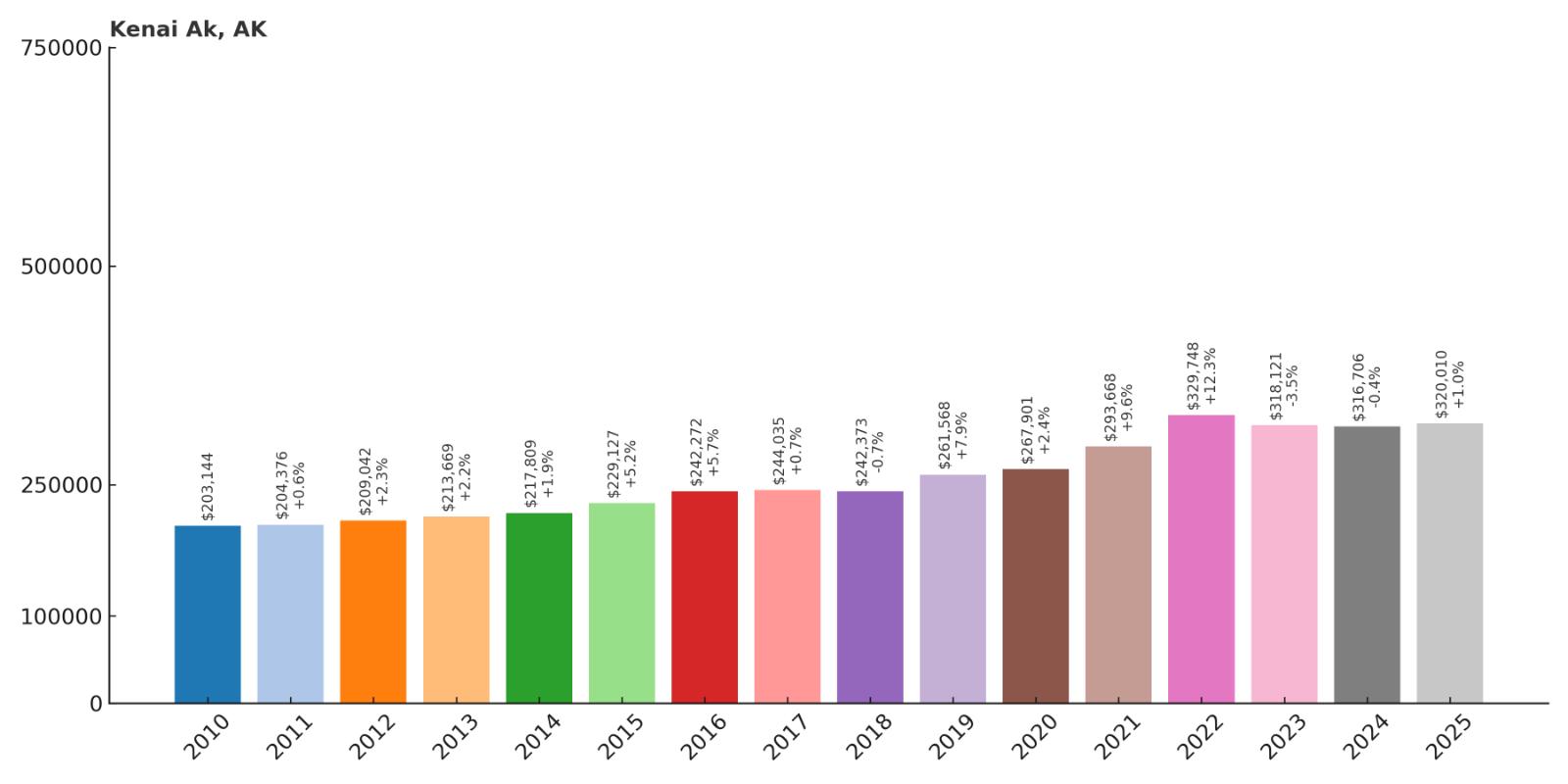
- 2010: $203,144
- 2011: $204,376
- 2012: $209,042
- 2013: $213,669
- 2014: $217,809
- 2015: $229,127
- 2016: $242,272
- 2017: $244,035
- 2018: $242,373
- 2019: $261,568
- 2020: $267,901
- 2021: $293,668
- 2022: $329,748
- 2023: $318,121
- 2024: $316,706
- 2025: $320,010
Kenai has shown consistent appreciation over 15 years, with home values rising from around $203,000 to $320,000. The community experienced steady growth through the 2010s before accelerating significantly from 2019-2022, adding over $68,000 in median value. Current pricing reflects some stabilization from pandemic peaks while maintaining strong value levels.
Why Kenai?
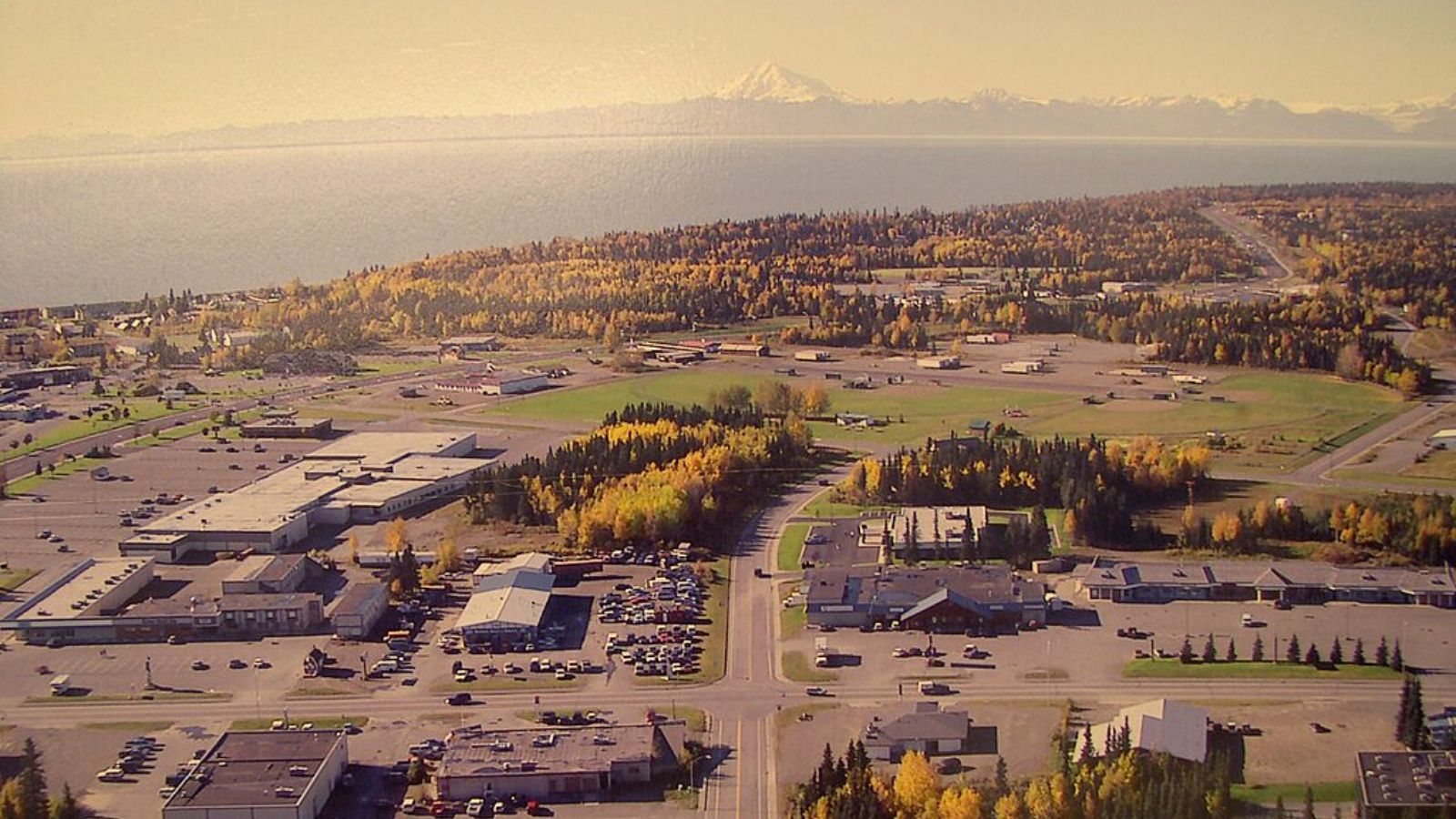
Why are people willing to pay so much to live here? What’s special about it?
Kenai combines rich cultural heritage with modern amenities as one of Alaska’s oldest continuously inhabited communities. The city offers excellent fishing access on the world-famous Kenai River, where king salmon regularly exceed 50 pounds. Residents enjoy stable employment opportunities in oil, fishing, and tourism industries while maintaining access to traditional subsistence activities.
The community provides comprehensive services including healthcare, education, and retail options unusual for a town of its size. Properties often feature river access or views, with many custom homes designed to take advantage of the spectacular natural setting. The combination of economic stability, recreational opportunities, and cultural significance creates lasting appeal for buyers.
How Kenai Rose to Prominence
Kenai’s history spans over 1,000 years, beginning with Dena’ina Athabascan settlements along the salmon-rich Kenai River. Russian fur traders established a fort here in 1791, making it one of the first European settlements in Alaska. The name “Kenai” comes from the Dena’ina word “ken” meaning “flat” or “meadow,” describing the river’s wide valley.
American settlement accelerated after the 1867 Alaska Purchase, with homesteaders attracted by fertile soil and abundant natural resources. The discovery of oil and natural gas in the 1950s transformed Kenai into a major energy center, with refineries and support industries providing stable, well-paying employment. Modern Kenai balances its role as an energy hub with tourism and fishing industries, creating a diverse economy that supports its position as a major Kenai Peninsula community.
3 Interesting Tidbits
1. King Salmon Capital – The Kenai River produces the world-record king salmon, with the current record of 97 pounds, 4 ounces caught here in 1985.
2. Russian Orthodox Heritage – Kenai’s Holy Assumption Russian Orthodox Church, built in 1895, represents one of Alaska’s most significant historic religious sites.
3. Oil Discovery Site – The first major oil discovery on the Kenai Peninsula occurred here in 1957, launching Alaska’s modern petroleum industry.
23. North Pole – 34% Home Price Increase Since 2010
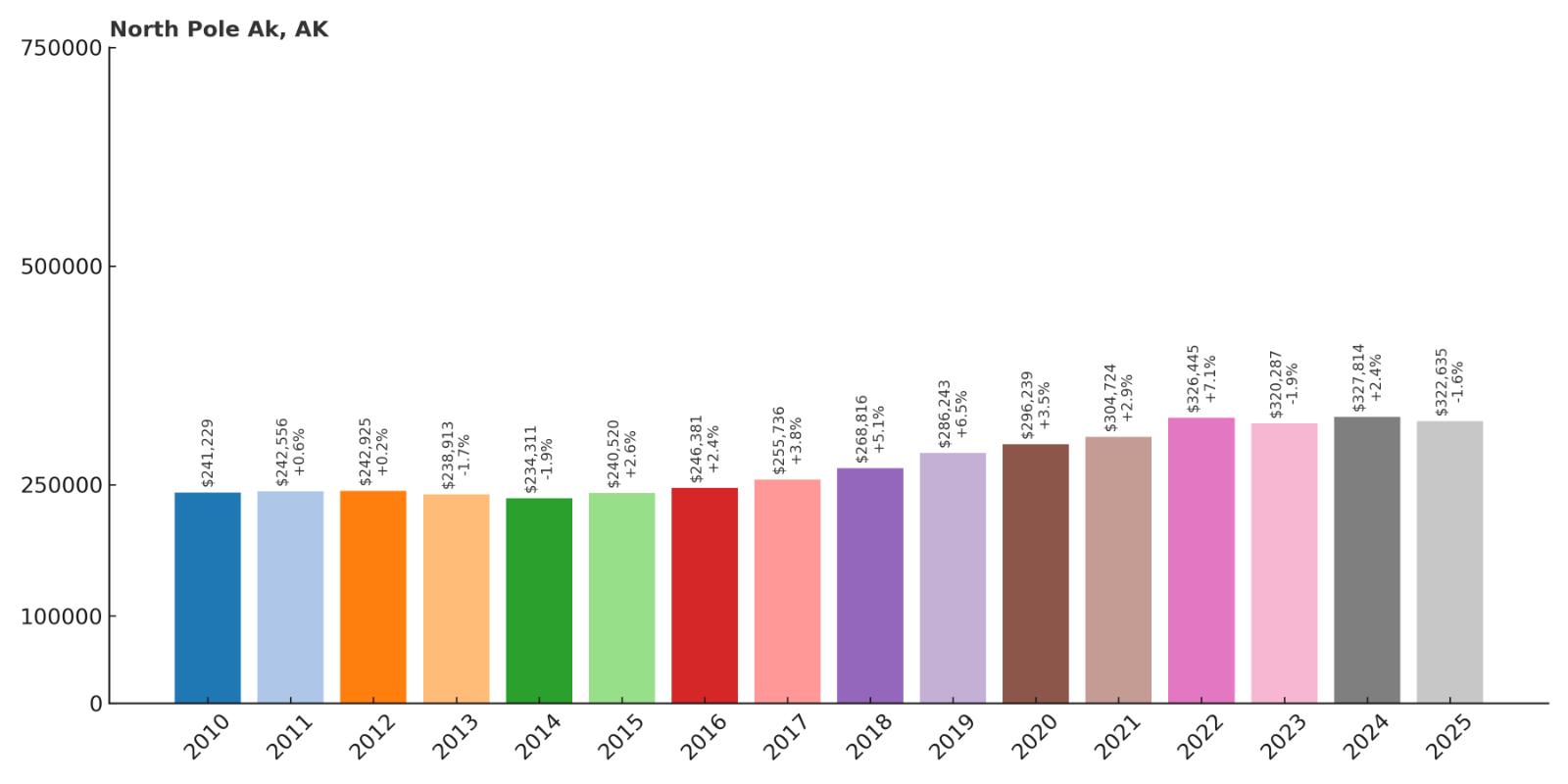
- 2010: $241,229
- 2011: $242,556
- 2012: $242,925
- 2013: $238,913
- 2014: $234,311
- 2015: $240,520
- 2016: $246,381
- 2017: $255,736
- 2018: $268,816
- 2019: $286,243
- 2020: $296,239
- 2021: $304,724
- 2022: $326,445
- 2023: $320,287
- 2024: $327,814
- 2025: $322,635
North Pole has achieved steady appreciation over 15 years, with home values rising from around $241,000 to $323,000. The community showed remarkable stability through the early 2010s before beginning consistent growth in the mid-2010s. Strong gains during the pandemic period brought values to current levels, with recent years showing continued stability.
Why North Pole?

Why are people willing to pay so much to live here? What’s special about it?
North Pole offers suburban living with a unique Christmas-themed identity that attracts families and tourism-related businesses. The community provides easy access to Fairbanks employment and services while maintaining lower density and larger lot sizes. Residents enjoy the novelty of year-round Christmas atmosphere alongside practical benefits of established infrastructure and services.
The city combines quirky charm with serious economic foundations, including military personnel from nearby bases and Fairbanks commuters seeking more space. Properties often feature larger lots and custom homes that balance suburban comfort with Alaska’s rugged lifestyle requirements. The stable economy and distinctive character help maintain consistent property values.
How North Pole Rose to Prominence
North Pole was founded in 1944 by Con Miller, a Fairbanks merchant who hoped to attract a toy manufacturer to the area by capitalizing on the Christmas-themed name. Miller’s plan was to entice toy companies with the marketing appeal of products “Made in North Pole, Alaska,” though no major manufacturers ultimately relocated here. The community grew slowly around its Christmas theme, with streets named Santa Claus Lane and Kris Kringle Drive.
The city’s development accelerated in the 1950s and 1960s as Fairbanks expanded and military installations grew. North Pole became an incorporated city in 1953, officially embracing its Christmas identity while developing as a bedroom community for Fairbanks workers. The establishment of a post office with the North Pole postmark created a thriving Christmas card business that continues today, cementing the city’s unique place in American popular culture.
3 Interesting Tidbits
1. Santa Claus House – The city’s famous Santa Claus House attraction receives hundreds of thousands of letters addressed to Santa each year, all bearing the official North Pole, Alaska postmark.
2. Christmas Street Names – The city maintains its theme with street names like Santa Claus Lane, Kris Kringle Drive, and Mistletoe Lane throughout the community.
3. Year-Round Christmas – Many local businesses maintain Christmas decorations and themes throughout the year, creating a unique atmosphere that attracts visitors from around the world.
22. Haines – 13% Home Price Increase Since 2021
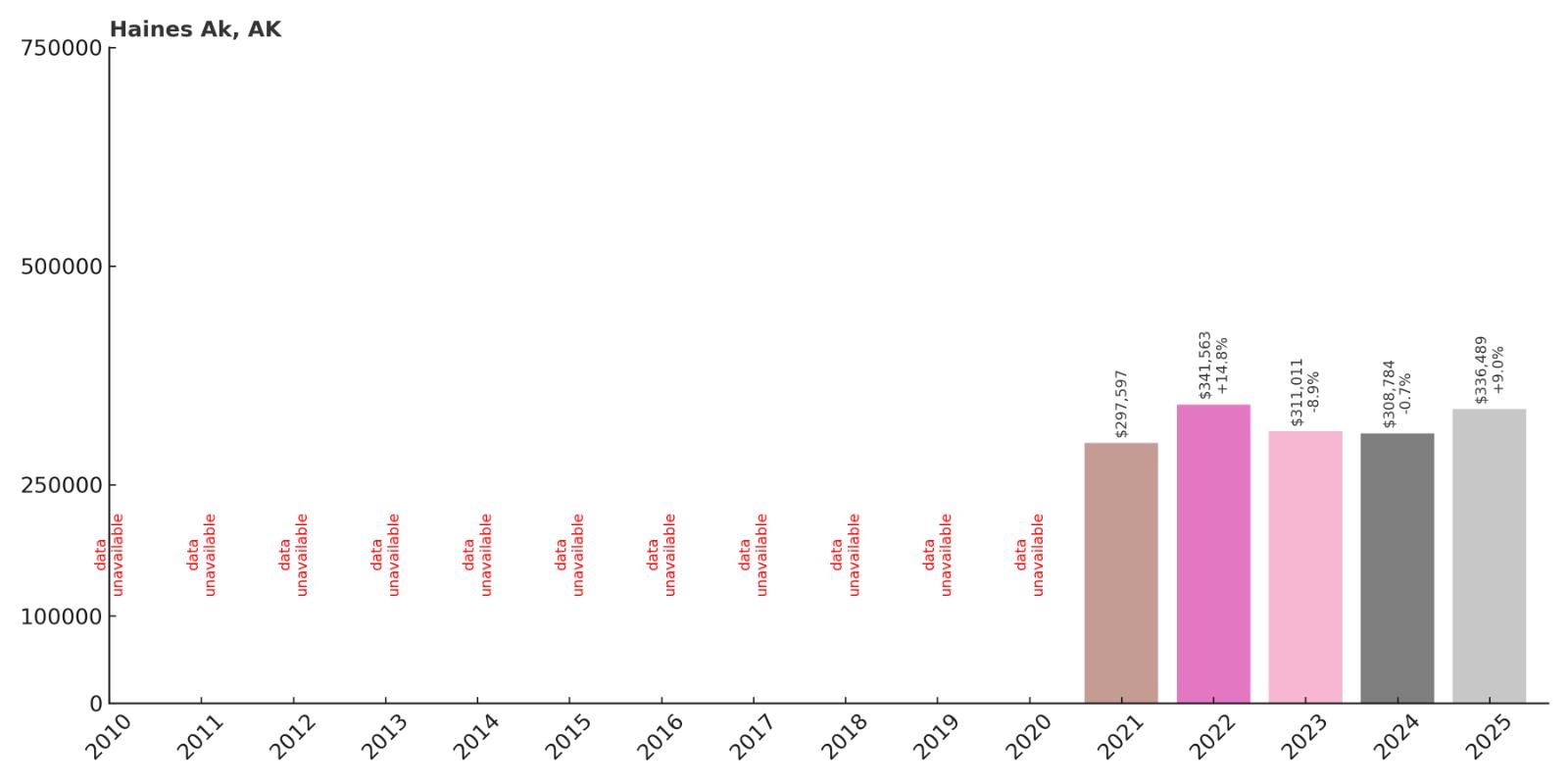
- 2010: N/A
- 2011: N/A
- 2012: N/A
- 2013: N/A
- 2014: N/A
- 2015: N/A
- 2016: N/A
- 2017: N/A
- 2018: N/A
- 2019: N/A
- 2020: N/A
- 2021: $297,597
- 2022: $341,563
- 2023: $311,011
- 2024: $308,784
- 2025: $336,489
Haines has shown recent growth since data became available in 2021, with home values rising from around $298,000 to over $336,000. The community experienced a significant spike in 2022 reaching over $341,000 before moderating in 2023-2024. Values have rebounded strongly in 2025, demonstrating the market’s underlying strength despite limited historical data.
Why Haines?

Why are people willing to pay so much to live here? What’s special about it?
Haines offers stunning natural beauty nestled between towering mountains and deep fjords in Southeast Alaska’s inside passage. The community provides road access to the outside world via the Alaska Highway, making it more accessible than many Southeast communities while maintaining small-town charm. Residents enjoy excellent outdoor recreation including world-class fishing, hiking, and winter sports.
The town combines artistic culture with outdoor lifestyle, hosting numerous festivals and maintaining an active arts community. Properties often feature mountain or water views with custom homes designed to take advantage of the dramatic setting. The balance of accessibility, natural beauty, and cultural amenities creates strong appeal for buyers seeking authentic Alaska living.
How Haines Rose to Prominence
Haines began as a Tlingit settlement called Dei-shu, meaning “end of the trail,” marking the terminus of important inland trading routes. Presbyterian missionaries established a mission here in 1881, naming it after Francina Haines, the secretary of the Presbyterian Women’s Executive Society who helped fund the mission. The location’s strategic position at the head of the Lynn Canal made it a natural supply point for interior Alaska.
The Klondike Gold Rush of 1896-1899 transformed Haines into a crucial supply depot for miners heading inland. Military activity increased during World War II with the construction of the Alaska Highway, which made Haines the first Southeast Alaska community accessible by road. Modern Haines developed around tourism, fishing, and its role as a transportation hub, while maintaining its reputation as an arts community and gateway to both Glacier Bay and interior Alaska.
3 Interesting Tidbits
1. Bald Eagle Capital – Haines hosts the world’s largest gathering of bald eagles each fall, with over 3,000 eagles congregating along the Chilkat River to feed on late salmon runs.
2. Hammer Museum – The town houses the world’s only museum dedicated entirely to hammers, featuring over 2,000 hammers from around the globe in a quirky celebration of this essential tool.
3. Road Connection – Haines is one of only three Southeast Alaska communities connected to the continental road system, making it a crucial transportation link for the region.
21. Delta Junction – 51% Home Price Increase Since 2016

- 2010: N/A
- 2011: N/A
- 2012: N/A
- 2013: N/A
- 2014: N/A
- 2015: N/A
- 2016: $222,513
- 2017: $215,343
- 2018: $235,657
- 2019: $236,581
- 2020: $257,372
- 2021: $314,065
- 2022: $359,927
- 2023: $299,477
- 2024: $321,901
- 2025: $336,812
Delta Junction has achieved impressive growth since 2016, with home values increasing from around $223,000 to nearly $337,000. The community experienced dramatic appreciation from 2020-2022, adding over $102,000 in median value during this period. After a correction in 2023, values have recovered strongly over the past two years.
Why Delta Junction?

Why are people willing to pay so much to live here? What’s special about it?
Delta Junction serves as the official end of the Alaska Highway, making it a symbolic destination for road travelers and a practical stop for those moving to Alaska. The community offers agricultural opportunities unusual in Alaska, with some of the state’s best farmland supporting barley and other crops. Residents enjoy lower cost of living compared to larger cities while maintaining access to services and transportation connections.
The area provides excellent hunting and fishing opportunities alongside agricultural lifestyle options that attract families seeking self-sufficient living. Properties often feature large lots suitable for farming, livestock, or simply enjoying space and privacy. The combination of agricultural potential, transportation access, and outdoor recreation creates appeal for diverse buyer groups.
How Delta Junction Rose to Prominence
Delta Junction began as a roadhouse and trading post in the early 1900s, serving travelers on the trail between Valdez and Fairbanks. The community’s location at the confluence of the Delta and Tanana rivers made it a natural stopping point for river transportation and later road travel. The area was originally inhabited by Athabascan peoples who used the river junction for seasonal camps and trading.
The construction of the Alaska Highway during World War II brought permanent settlement and established Delta Junction as the highway’s official northern terminus. Post-war agricultural development transformed the area into Alaska’s primary farming region, with large-scale barley production beginning in the 1970s. Modern Delta Junction serves as both an agricultural center and a gateway community for visitors completing the Alaska Highway journey, maintaining its role as a crucial transportation and economic hub for Interior Alaska.
3 Interesting Tidbits
1. Alaska Highway Mile 1422 – Delta Junction marks the official end of the Alaska Highway at historic Milepost 1422, making it a pilgrimage destination for road trip enthusiasts.
2. Agricultural Hub – The area produces most of Alaska’s domestically grown barley, with some farms covering thousands of acres in the fertile Tanana Valley.
3. Bison Range – The nearby Delta Junction Bison Range supports Alaska’s only free-roaming bison herd, descendants of animals transplanted from Montana in the 1920s.
20. Diamond Ridge – 69% Home Price Increase Since 2010
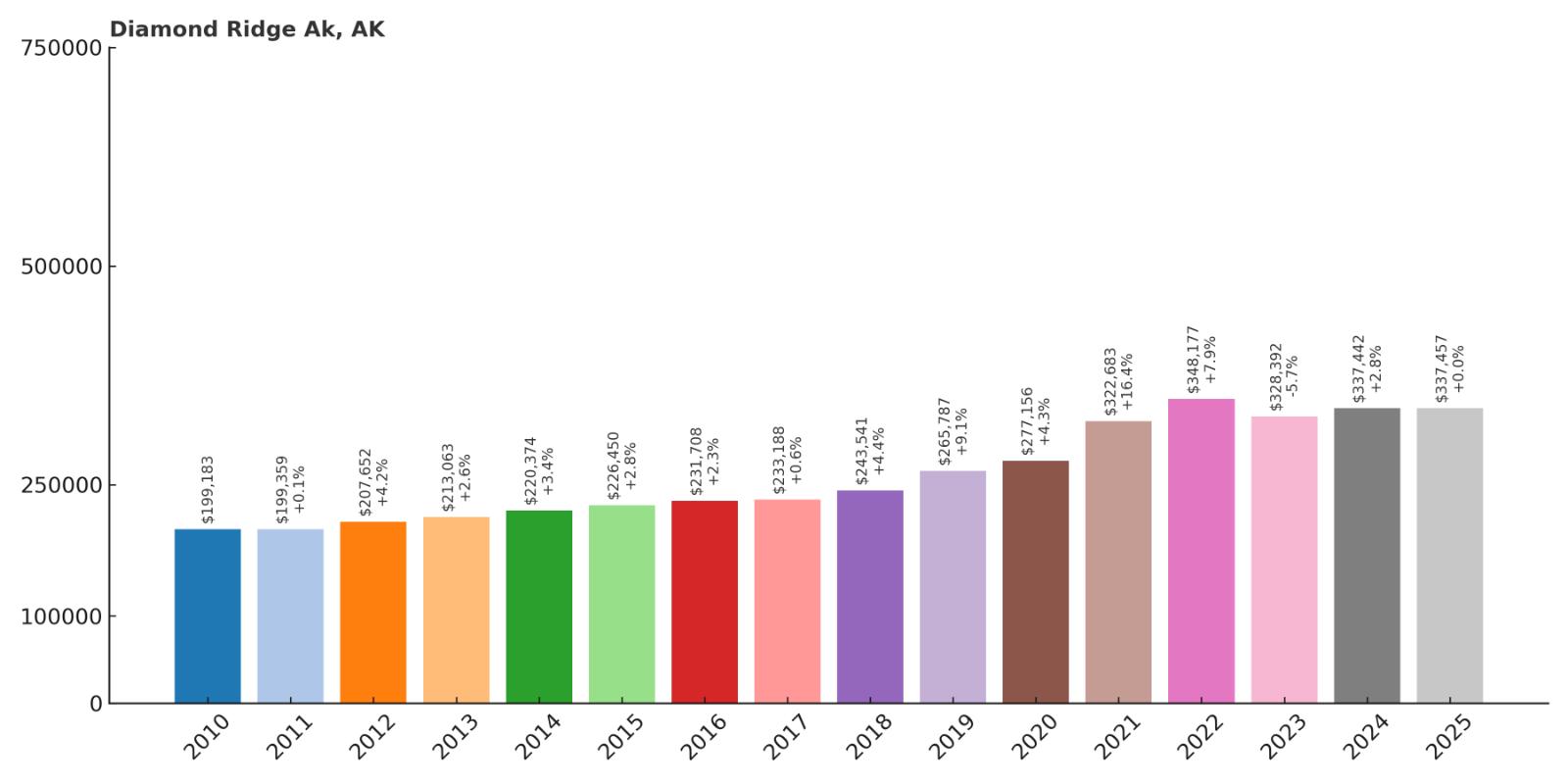
- 2010: $199,183
- 2011: $199,359
- 2012: $207,652
- 2013: $213,063
- 2014: $220,374
- 2015: $226,450
- 2016: $231,708
- 2017: $233,188
- 2018: $243,541
- 2019: $265,787
- 2020: $277,156
- 2021: $322,683
- 2022: $348,177
- 2023: $328,392
- 2024: $337,442
- 2025: $337,457
Diamond Ridge has demonstrated strong appreciation over 15 years, with home values climbing from around $199,000 to over $337,000. The community showed steady growth through the 2010s before accelerating dramatically during the pandemic period, adding over $70,000 from 2019-2022. Current values have stabilized near record highs after modest fluctuations in recent years.
Why Diamond Ridge?

Why are people willing to pay so much to live here? What’s special about it?
Diamond Ridge offers elevated living with panoramic views of Cook Inlet, Mount McKinley, and surrounding mountain ranges from the Kenai Peninsula’s ridge lines. The community provides semi-rural lifestyle with larger lots and custom homes while maintaining reasonable access to Homer and other peninsula communities. Residents enjoy privacy and space while staying connected to services and amenities.
The area attracts buyers seeking mountain living with ocean views, a combination rare even in Alaska. Properties often feature custom architecture designed to maximize the spectacular setting and take advantage of the region’s natural beauty. The limited development and protected viewsheds help maintain property values and the area’s exclusive character.
How Diamond Ridge Rose to Prominence
Diamond Ridge developed as homesteaders in the 1960s and 1970s sought elevated building sites above the Kenai Peninsula’s coastal areas. The ridge’s name comes from early settlers who noted how snow and ice formations on the ridgeline sparkled like diamonds in the sunlight. Initial development was slow due to challenging access and the need for private wells and septic systems on the elevated terrain.
Growth accelerated in the 1980s and 1990s as improved roads and services made the area more accessible to those seeking custom home sites with exceptional views. The community developed as an enclave for successful professionals and retirees who valued privacy, natural beauty, and proximity to both Homer and Anchorage. Modern Diamond Ridge represents one of Alaska’s premier residential areas, combining luxury living with rugged natural settings.
3 Interesting Tidbits
1. View Properties – Many Diamond Ridge homes offer simultaneous views of Cook Inlet, Kachemak Bay, and Mount McKinley on clear days, creating some of Alaska’s most spectacular residential vistas.
2. Custom Home Haven – The area features predominantly custom-built homes designed by architects to take advantage of specific site conditions and maximize view potential.
3. Elevation Advantage – The ridge’s elevation provides natural protection from coastal weather while offering superior drainage and building conditions compared to lower areas.
19. Sterling – 74% Home Price Increase Since 2010
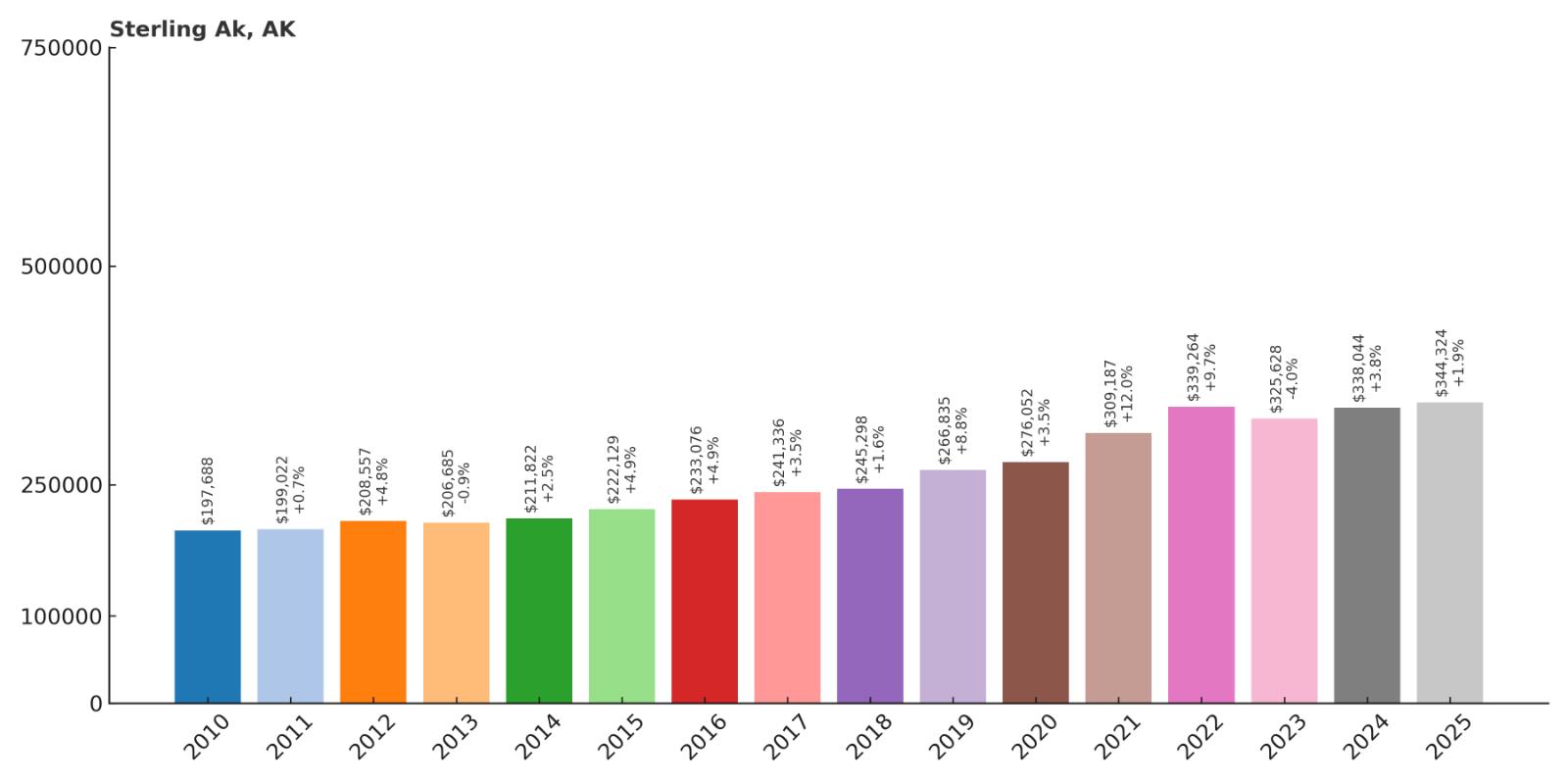
- 2010: $197,688
- 2011: $199,022
- 2012: $208,557
- 2013: $206,685
- 2014: $211,822
- 2015: $222,129
- 2016: $233,076
- 2017: $241,336
- 2018: $245,298
- 2019: $266,835
- 2020: $276,052
- 2021: $309,187
- 2022: $339,264
- 2023: $325,628
- 2024: $338,044
- 2025: $344,324
Sterling has achieved substantial appreciation over 15 years, with home values rising from under $198,000 to over $344,000. The community maintained steady growth through the 2010s before experiencing significant acceleration from 2019-2022, adding over $72,000 in median value. Recent years have shown continued strength with values reaching new highs in 2025.
Why Sterling?

Why are people willing to pay so much to live here? What’s special about it?
Sterling provides prime access to some of Alaska’s best salmon fishing on the Kenai River system, attracting anglers from around the world during peak season. The community offers rural living with established services and infrastructure while maintaining the outdoor recreation lifestyle that draws many to Alaska. Residents enjoy larger lots and custom homes in a setting that balances development with natural preservation.
The area serves as a hub for outdoor enthusiasts seeking fishing, hunting, and wilderness access while providing modern amenities and services. Properties often feature river access or proximity to world-class fishing opportunities. The combination of recreational appeal, established community infrastructure, and natural beauty creates strong demand from both permanent residents and seasonal property owners.
How Sterling Rose to Prominence
Sterling began as a homestead community in the 1940s and 1950s when veterans and other settlers were attracted by available land and fishing opportunities along the Kenai River. The area was named after early homesteader Harry Sterling, who established one of the first permanent settlements in the region. Early residents combined subsistence activities with small-scale farming and guiding services for visiting anglers.
The community’s growth accelerated with the development of the Kenai Peninsula’s road system in the 1960s and 1970s, making Sterling more accessible to visitors and new residents. The area became renowned for its exceptional fishing opportunities, particularly for king and silver salmon, attracting both sport fishers and those seeking commercial fishing opportunities. Modern Sterling has evolved into one of Alaska’s premier fishing communities, balancing residential development with preservation of the natural resources that define its character.
3 Interesting Tidbits
1. Fishing Mecca – Sterling provides access to multiple world-class salmon fishing areas including the famous Kenai River, Russian River, and numerous smaller streams and lakes.
2. Canoe Trail System – The area features an extensive system of interconnected lakes and waterways perfect for canoeing and kayaking through pristine wilderness areas.
3. Wildlife Corridor – Sterling sits along major wildlife migration routes, providing residents regular opportunities to view moose, bears, and other Alaska wildlife from their properties.
18. Valdez – 2% Home Price Increase Since 2022
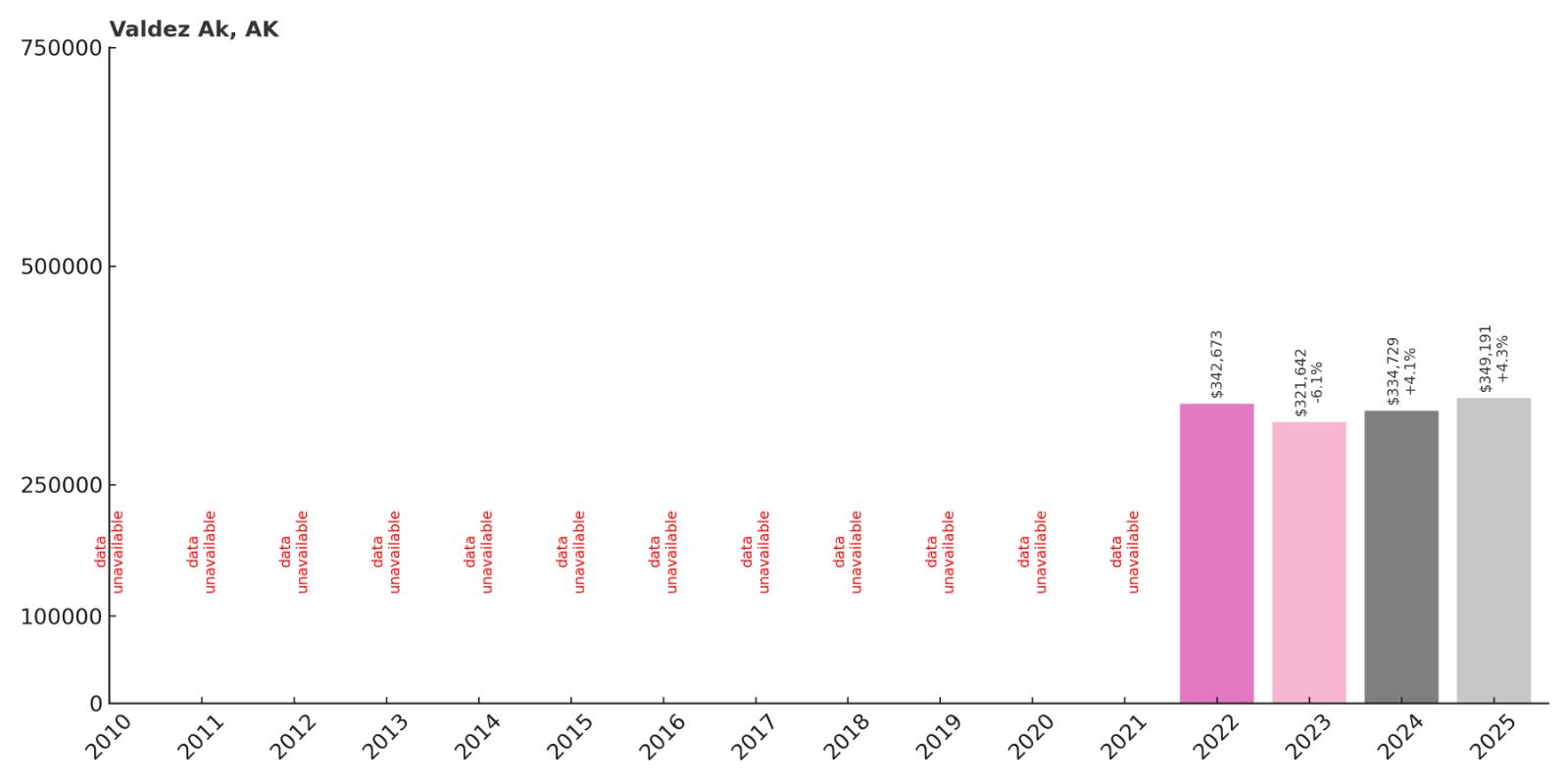
- 2010: N/A
- 2011: N/A
- 2012: N/A
- 2013: N/A
- 2014: N/A
- 2015: N/A
- 2016: N/A
- 2017: N/A
- 2018: N/A
- 2019: N/A
- 2020: N/A
- 2021: N/A
- 2022: $342,673
- 2023: $321,642
- 2024: $334,729
- 2025: $349,191
Valdez has shown modest growth since data became available in 2022, with home values rising from around $343,000 to nearly $349,000. The community experienced a dip in 2023 before recovering strongly over the past two years. Current values represent the highest levels recorded, demonstrating underlying market strength despite limited historical data.
Why Valdez?

Why are people willing to pay so much to live here? What’s special about it?
Valdez serves as the southern terminus of the Trans-Alaska Pipeline, providing stable, high-paying employment in the oil industry along with related maritime and support services. The community offers dramatic mountain and ocean scenery in Prince William Sound, with world-class fishing and outdoor recreation opportunities. Residents enjoy small-town living with the economic benefits of major industrial infrastructure.
The town combines industrial prosperity with stunning natural beauty, creating a unique living environment where well-paying jobs meet exceptional outdoor lifestyle opportunities. Properties often feature water or mountain views with custom homes designed for Alaska’s challenging climate. The stable economy and spectacular setting create lasting appeal for those seeking both career opportunities and quality of life.
How Valdez Rose to Prominence
Valdez was founded in 1897 as a port town during the Klondike Gold Rush, serving as the starting point for the treacherous Valdez Glacier Trail to interior goldfields. The town was named after Antonio Valdés y Fernández Bazán, a Spanish naval officer. The 1964 Good Friday earthquake completely destroyed the original townsite, leading to reconstruction at the current location four miles away from the earthquake and tsunami damage.
The discovery of oil at Prudhoe Bay in 1968 transformed Valdez when it was selected as the southern terminus of the Trans-Alaska Pipeline in 1974. Construction of the pipeline and terminal brought massive economic development and established Valdez as a crucial energy infrastructure hub. The 1989 Exxon Valdez oil spill brought international attention and led to improved environmental protections, while the community continued to thrive as Alaska’s primary oil export port.
3 Interesting Tidbits
1. Pipeline Terminus – Valdez serves as the southern endpoint of the 800-mile Trans-Alaska Pipeline, where North Slope crude oil is loaded onto tankers for worldwide distribution.
2. Earthquake Resilience – The entire town was relocated and rebuilt after the devastating 1964 earthquake, creating one of Alaska’s most modern and well-planned communities.
3. Ice-Free Port – Despite its northern latitude, Valdez maintains an ice-free deep-water port year-round, making it crucial for Alaska’s maritime commerce and oil exports.
17. Soldotna – 57% Home Price Increase Since 2010
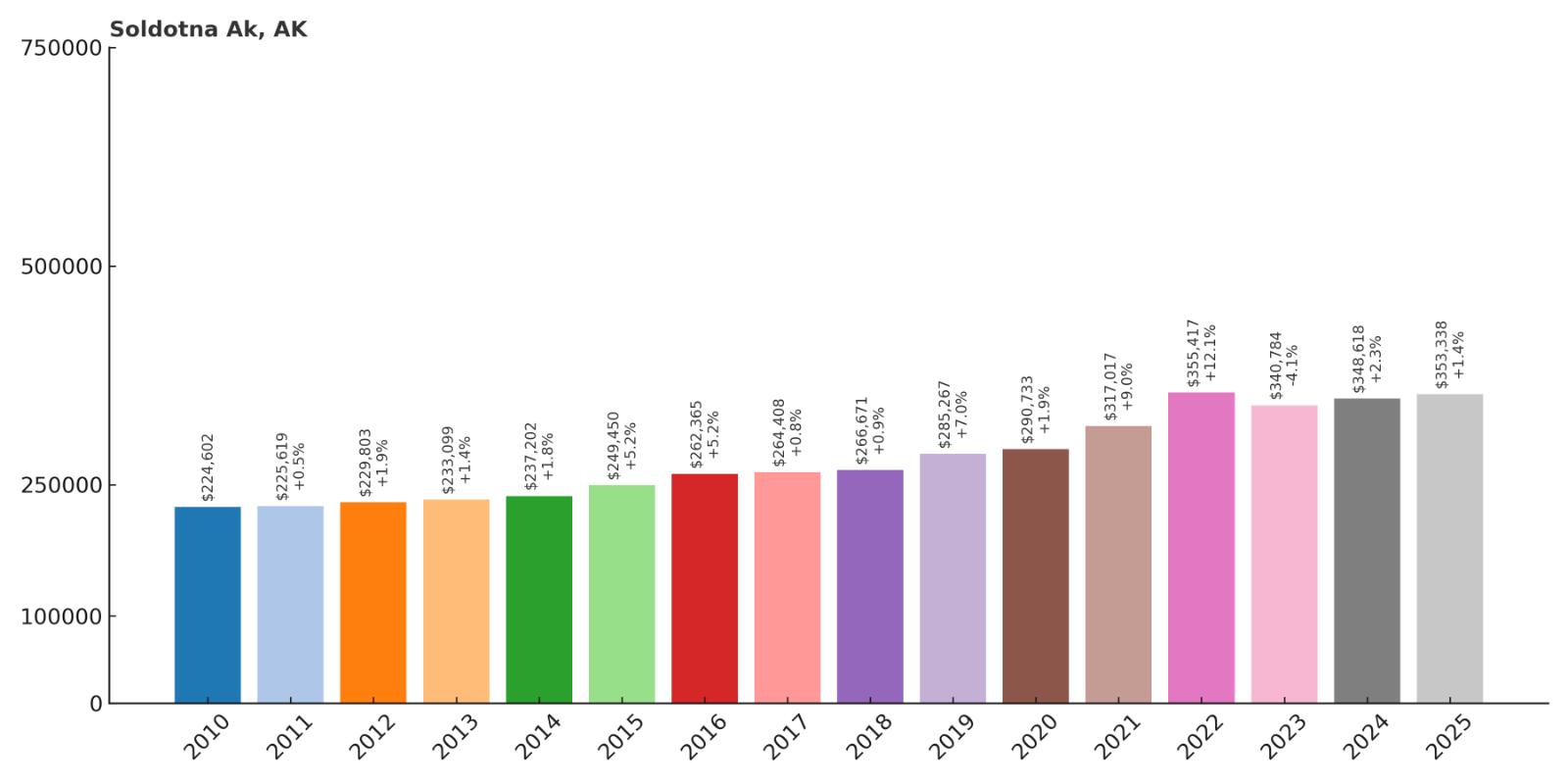
- 2010: $224,602
- 2011: $225,619
- 2012: $229,803
- 2013: $233,099
- 2014: $237,202
- 2015: $249,450
- 2016: $262,365
- 2017: $264,408
- 2018: $266,671
- 2019: $285,267
- 2020: $290,733
- 2021: $317,017
- 2022: $355,417
- 2023: $340,784
- 2024: $348,618
- 2025: $353,338
Soldotna has shown consistent appreciation over 15 years, with home values rising from around $225,000 to over $353,000. The community maintained steady growth through the 2010s before experiencing significant acceleration from 2020-2022, adding over $64,000 in median value. Current pricing represents continued strength with values reaching new highs in 2025.
Why Soldotna?

Why are people willing to pay so much to live here? What’s special about it?
Soldotna serves as the commercial and government center of the Kenai Peninsula, providing comprehensive services, employment opportunities, and urban amenities in a setting that maintains access to world-class outdoor recreation. The city offers excellent schools, healthcare facilities, and retail options while sitting at the heart of Alaska’s premier fishing region. Residents enjoy the balance of small-city conveniences with easy access to wilderness and fishing opportunities.
The community provides stable year-round employment in government, healthcare, education, and service industries while maintaining its identity as a fishing destination. Properties range from urban neighborhoods to larger lots on the city’s outskirts, accommodating diverse lifestyle preferences. The combination of economic stability, comprehensive services, and recreational access creates strong demand from families and professionals.
How Soldotna Rose to Prominence
Soldotna began as a homestead community in the 1940s and 1950s, established by World War II veterans attracted by available land and fishing opportunities on the Kenai River. The town was officially incorporated in 1967, becoming the fastest-growing community on the Kenai Peninsula. The name “Soldotna” comes from a Russian word meaning “soldier’s town,” reflecting the area’s appeal to military veterans.
The community’s growth accelerated when it was selected as the seat of the newly formed Kenai Peninsula Borough in 1964, bringing government employment and establishing Soldotna as the region’s administrative center. Development of the peninsula’s road system and the growth of tourism, particularly sport fishing, transformed Soldotna into the Kenai Peninsula’s primary service center. Modern Soldotna balances its roles as a government center, commercial hub, and fishing destination, creating a diverse economy that supports its position as the peninsula’s largest city.
3 Interesting Tidbits
1. World-Class Fishing – Soldotna sits at the confluence of the Kenai and Moose rivers, providing access to some of the world’s best king salmon fishing with multiple state records caught locally.
2. Progress Days Festival – The annual Soldotna Progress Days celebration features one of Alaska’s largest hometown festivals, attracting visitors from across the state for its parade, rodeo, and community events.
3. Government Hub – As the Kenai Peninsula Borough seat, Soldotna serves over 55,000 residents across the peninsula, making it one of Alaska’s most important regional government centers.
16. Petersburg – 14% Home Price Increase Since 2017
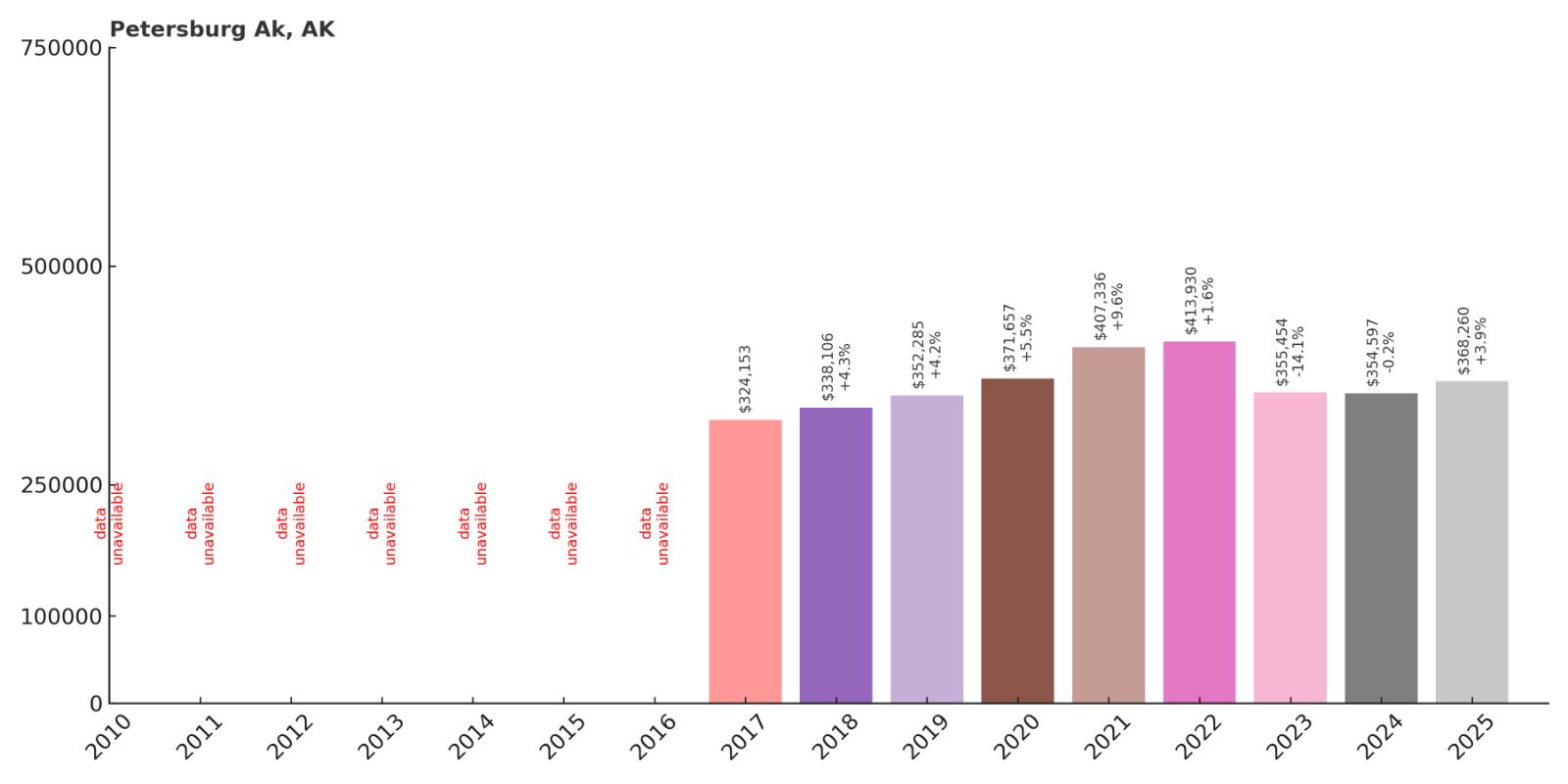
- 2010: N/A
- 2011: N/A
- 2012: N/A
- 2013: N/A
- 2014: N/A
- 2015: N/A
- 2016: N/A
- 2017: $324,153
- 2018: $338,106
- 2019: $352,285
- 2020: $371,657
- 2021: $407,336
- 2022: $413,930
- 2023: $355,454
- 2024: $354,597
- 2025: $368,260
Petersburg has shown moderate growth since 2017, with home values rising from around $324,000 to over $368,000. The community experienced strong appreciation through 2022, reaching over $413,000 before experiencing a notable correction in 2023-2024. Values have begun recovering in 2025, demonstrating market resilience despite volatility.
Why Petersburg?

Why are people willing to pay so much to live here? What’s special about it?
Petersburg offers authentic small-town Alaska living with strong Norwegian cultural heritage and one of the state’s most active fishing economies. The community provides island living with excellent access to Southeast Alaska’s pristine wilderness and marine environments. Residents enjoy a tight-knit community atmosphere while maintaining economic opportunities in fishing, tourism, and government services.
The town features distinctive Scandinavian architecture and cultural traditions that create a unique character among Alaska communities. Properties often feature waterfront access and views of Frederick Sound and surrounding mountains. The combination of cultural heritage, economic stability, and natural beauty attracts buyers seeking authentic Alaska community living.
How Petersburg Rose to Prominence
Petersburg was founded in 1897 by Norwegian fisherman Peter Buschmann, who established a cannery and sawmill at the current townsite. The community attracted Norwegian and Scandinavian immigrants who were drawn by familiar fishing opportunities and the town’s resemblance to Norwegian fjord communities. The name “Petersburg” honors both the founder and the town’s Norwegian heritage, earning it the nickname “Little Norway.”
The community developed around fishing and fish processing, becoming one of Alaska’s most important seafood centers. Petersburg’s location on Mitkof Island provided excellent access to rich fishing grounds while offering protection from Southeast Alaska’s severe weather. The town maintained its Norwegian cultural identity while growing into a major regional fishing hub, with modern Petersburg continuing to balance its cultural heritage with its role as one of Alaska’s most productive fishing communities.
3 Interesting Tidbits
1. Little Norway – Petersburg maintains strong Norwegian cultural traditions including the annual Little Norway Festival, traditional rosemaling architecture, and Scandinavian-style buildings throughout downtown.
2. Fishing Capital – The community hosts one of Alaska’s largest fishing fleets and processes more seafood per capita than almost any other Alaska town.
3. Devil’s Thumb – The nearby Devil’s Thumb peak provides a dramatic backdrop and challenging climbing destination that attracts mountaineers from around the world.
15. Meadow Lakes – 80% Home Price Increase Since 2010
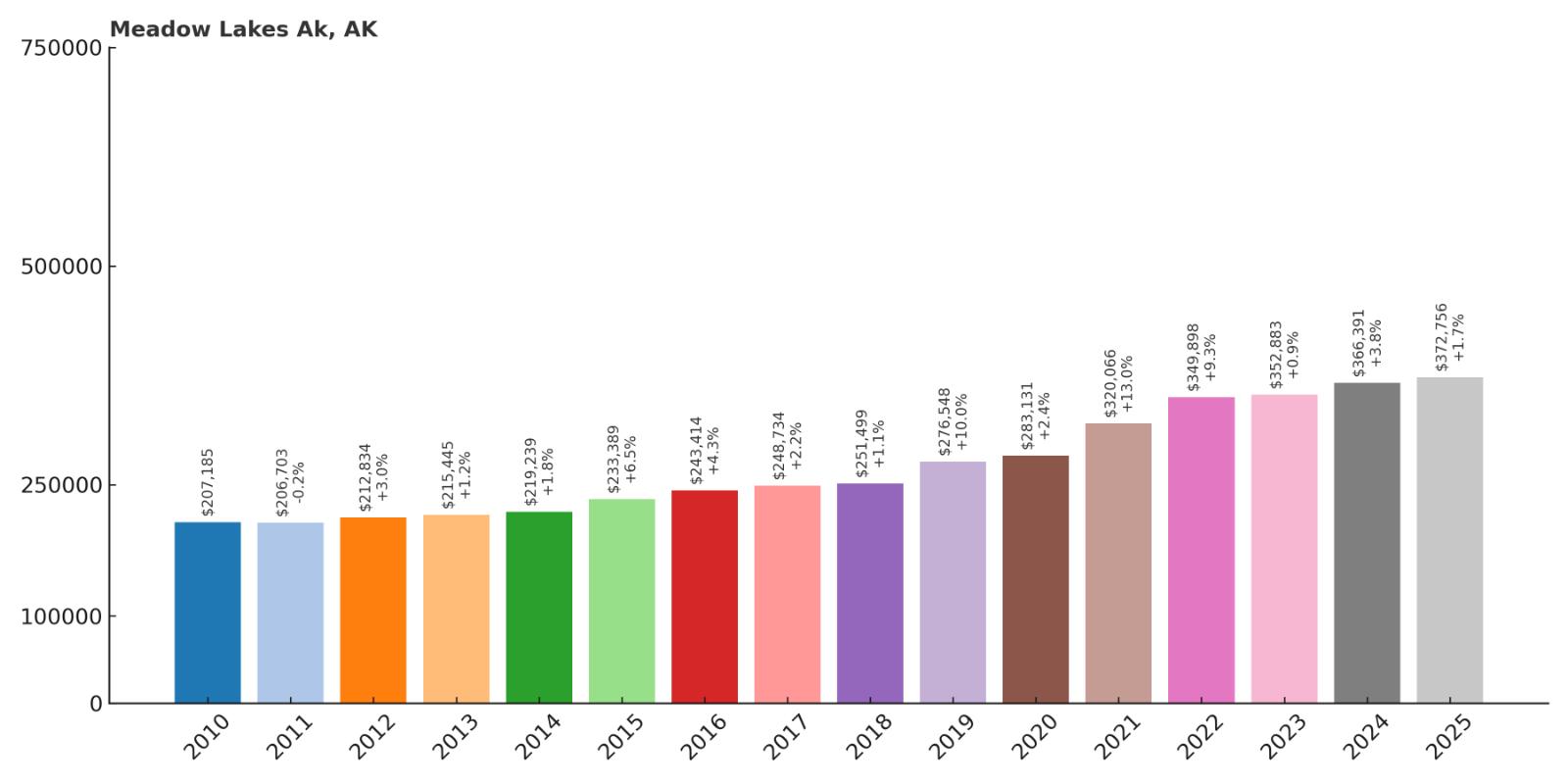
- 2010: $207,185
- 2011: $206,703
- 2012: $212,834
- 2013: $215,445
- 2014: $219,239
- 2015: $233,389
- 2016: $243,414
- 2017: $248,734
- 2018: $251,499
- 2019: $276,548
- 2020: $283,131
- 2021: $320,066
- 2022: $349,898
- 2023: $352,883
- 2024: $366,391
- 2025: $372,756
Meadow Lakes has achieved substantial appreciation over 15 years, with home values rising from around $207,000 to over $372,000. The community showed steady growth through the 2010s before accelerating significantly from 2019-2022, adding over $73,000 in median value. Growth has continued through 2025, with values reaching new record highs.
Why Meadow Lakes?

Why are people willing to pay so much to live here? What’s special about it?
Meadow Lakes provides suburban living in the Matanuska-Susitna Valley with easy commuting access to Anchorage while offering larger lots and more affordable housing than the city. The community attracts families seeking space, privacy, and outdoor recreation opportunities while maintaining access to urban employment and services. Residents enjoy the Alaska lifestyle with modern conveniences and excellent schools.
The area offers a blend of rural character and suburban amenities, with properties often featuring custom homes on multi-acre lots. Many residents value the community’s family-friendly atmosphere and strong sense of neighborhood while benefiting from proximity to both wilderness areas and urban centers. The combination of affordability, space, and accessibility creates strong appeal for growing families and commuters.
How Meadow Lakes Rose to Prominence
Meadow Lakes developed from homestead lands in the Matanuska-Susitna Valley, originally settled by families seeking agricultural opportunities and space for livestock. The area’s name comes from the numerous small lakes and meadows that characterize the landscape, providing natural beauty and wildlife habitat. Early development was slow due to limited road access and the need for private wells and septic systems.
Growth accelerated in the 1980s and 1990s as improved highways made commuting to Anchorage more feasible, transforming Meadow Lakes into a bedroom community for city workers. The area attracted families seeking affordable land for custom homes while maintaining access to Anchorage employment and services. Modern Meadow Lakes represents one of Alaska’s most successful suburban communities, balancing growth with preservation of its rural character and natural setting.
3 Interesting Tidbits
1. Lake Paradise – The community features dozens of small lakes that provide excellent fishing, boating, and wildlife viewing opportunities right in residents’ backyards.
2. Commuter Haven – Many Meadow Lakes residents work in Anchorage but choose to live here for the space, privacy, and outdoor lifestyle the valley provides.
3. Horse Country – The area maintains a strong equestrian culture with numerous horse properties, riding trails, and equestrian events throughout the year.
14. Seward – 87% Home Price Increase Since 2010
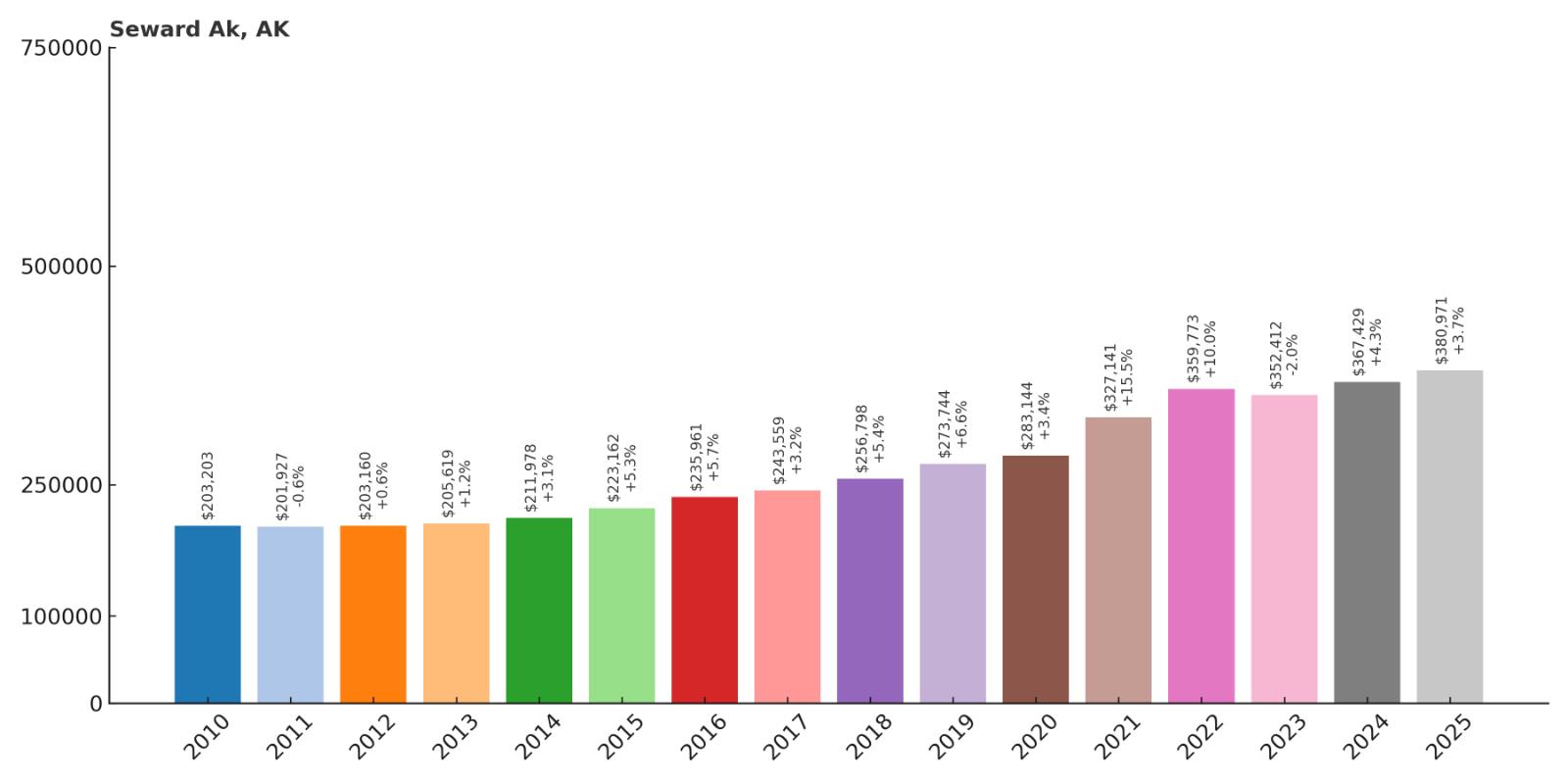
- 2010: $203,203
- 2011: $201,927
- 2012: $203,160
- 2013: $205,619
- 2014: $211,978
- 2015: $223,162
- 2016: $235,961
- 2017: $243,559
- 2018: $256,798
- 2019: $273,744
- 2020: $283,144
- 2021: $327,141
- 2022: $359,773
- 2023: $352,412
- 2024: $367,429
- 2025: $380,971
Seward has demonstrated impressive appreciation over 15 years, with home values rising from around $203,000 to over $380,000. The community showed steady growth through the 2010s before experiencing dramatic acceleration from 2020-2022, adding over $76,000 in median value. After a brief dip in 2023, values have continued climbing to reach new record highs.
Why Seward?

Why are people willing to pay so much to live here? What’s special about it?
Seward combines historic charm with modern tourism infrastructure as the gateway to Kenai Fjords National Park and one of Alaska’s most scenic coastal communities. The city offers year-round employment in tourism, fishing, and transportation while providing exceptional outdoor recreation access including world-class fishing and marine wildlife viewing. Residents enjoy small-town living with the economic benefits of a major tourist destination.
The community features a picturesque harbor setting surrounded by mountains and glaciers, creating one of Alaska’s most photogenic townscapes. Properties often feature water or mountain views with historic homes and modern developments side by side. The combination of natural beauty, economic opportunity, and cultural attractions creates lasting appeal for both residents and visitors.
How Seward Rose to Prominence
Seward was founded in 1903 as the southern terminus of the Alaska Railroad, named after William Seward, the Secretary of State who negotiated the Alaska Purchase. The town’s ice-free deep-water port made it crucial for Alaska’s development, serving as the primary gateway for people and goods traveling to interior Alaska. Early growth centered around railroad operations, shipping, and fishing industries.
The 1964 Good Friday earthquake devastated Seward’s waterfront and downtown, but the community rebuilt stronger with improved infrastructure and planning. The completion of the Seward Highway connected the town to Anchorage, while the designation of Kenai Fjords National Park in 1980 established Seward as a major tourism destination. Modern Seward balances its roles as a transportation hub, fishing port, and tourist gateway, creating a diverse economy that supports year-round residents and seasonal businesses.
3 Interesting Tidbits
1. Mount Marathon Race – Seward hosts the famous Mount Marathon race each July 4th, where runners sprint up and down a 3,022-foot mountain in one of America’s most challenging foot races.
2. Railroad Terminus – The Alaska Railroad’s southern terminus remains in Seward, where cruise ship passengers and tourists begin their journey into Alaska’s interior.
3. Iditarod Start – Seward served as the original starting point for the Iditarod Trail, the historic route that connected the coast to interior Alaska’s goldfields.
13. Cordova – 2% Home Price Increase Since 2022

- 2010: N/A
- 2011: N/A
- 2012: N/A
- 2013: N/A
- 2014: N/A
- 2015: N/A
- 2016: N/A
- 2017: N/A
- 2018: N/A
- 2019: N/A
- 2020: N/A
- 2021: N/A
- 2022: $379,699
- 2023: $330,556
- 2024: $336,230
- 2025: $388,644
Cordova has shown recent volatility since data became available in 2022, with values starting around $380,000, dropping significantly in 2023, then surging to nearly $389,000 in 2025. Despite limited historical data, the community has demonstrated underlying market strength with current values exceeding initial 2022 levels.
Why Cordova?

Why are people willing to pay so much to live here? What’s special about it?
Cordova offers authentic Alaska fishing community living with some of the state’s most productive commercial fishing opportunities and spectacular wilderness access. The town provides island isolation that appeals to those seeking escape from urban pressures while maintaining essential services and strong community bonds. Residents enjoy exceptional outdoor recreation including world-class fishing, hunting, and wildlife viewing.
The community maintains traditional Alaska character with an economy based on fishing and seasonal tourism, creating a lifestyle that attracts those seeking authentic small-town Alaska experiences. Properties often feature waterfront access and views of Prince William Sound’s pristine environment. Limited accessibility and housing supply contribute to premium pricing for available homes.
How Cordova Rose to Prominence
Cordova was established in 1906 as the coastal terminus of the Copper River and Northwestern Railway, built to transport copper ore from interior mines to ships bound for smelters in the continental United States. The town was named after the Spanish explorer Salvador Fidalgo’s ship Cordova, reflecting Alaska’s complex colonial history. The community thrived during the copper mining boom, supporting thousands of workers and their families.
When copper mining ended in 1938, Cordova reinvented itself as a fishing community, taking advantage of its excellent harbor and proximity to rich fishing grounds in Prince William Sound and the Gulf of Alaska. The town developed one of Alaska’s most productive fishing fleets, specializing in salmon, herring, and crab. Modern Cordova maintains its identity as a working fishing town while embracing eco-tourism and its role as a gateway to wilderness areas.
3 Interesting Tidbits
1. Copper River Salmon – Cordova is famous for Copper River salmon, considered among the world’s finest due to their high oil content and exceptional flavor, commanding premium prices worldwide.
2. Million Dollar Bridge – The historic Copper River Railway bridge, known as the “Million Dollar Bridge,” still stands as a testament to early 20th-century engineering in one of Alaska’s most challenging environments.
3. Iceworm Festival – Cordova’s annual Iceworm Festival in February celebrates winter with quirky traditions including the crowning of an Iceworm Queen and a parade featuring a giant iceworm puppet.
12. Ketchikan – 73% Home Price Increase Since 2010
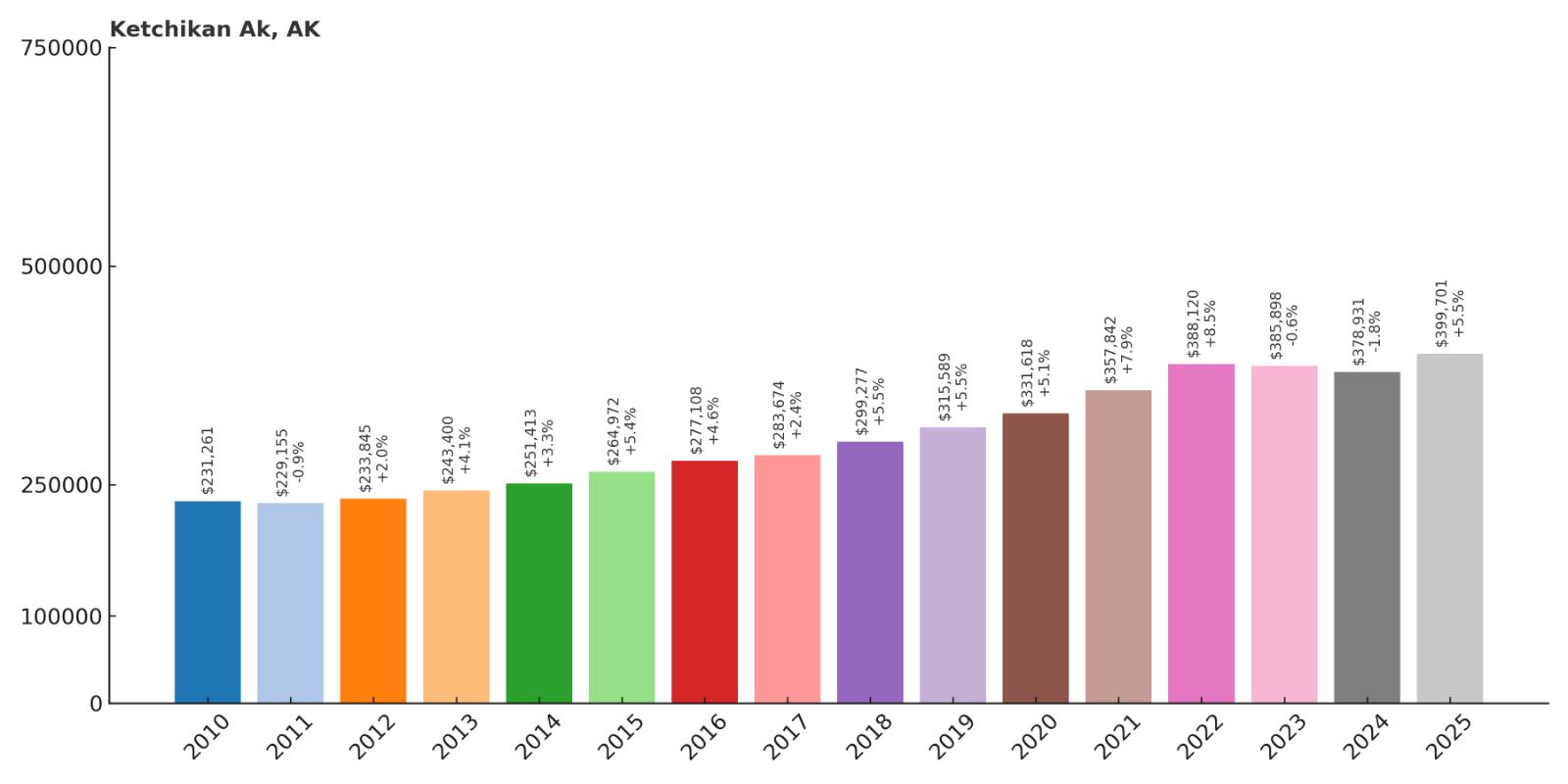
- 2010: $231,261
- 2011: $229,155
- 2012: $233,845
- 2013: $243,400
- 2014: $251,413
- 2015: $264,972
- 2016: $277,108
- 2017: $283,674
- 2018: $299,277
- 2019: $315,589
- 2020: $331,618
- 2021: $357,842
- 2022: $388,120
- 2023: $385,898
- 2024: $378,931
- 2025: $399,701
Ketchikan has achieved substantial appreciation over 15 years, with home values rising from around $231,000 to nearly $400,000. The community maintained consistent growth throughout the 2010s before accelerating significantly from 2019-2022, adding over $72,000 in median value. After modest fluctuations, values have surged to new record highs in 2025.
Why Ketchikan?

Why are people willing to pay so much to live here? What’s special about it?
Ketchikan serves as Southeast Alaska’s first major port of call for cruise ships and the gateway to the region’s spectacular wilderness areas and cultural attractions. The city offers stable employment in tourism, fishing, government, and transportation while providing urban amenities unusual in Southeast Alaska. Residents enjoy temperate climate, extensive services, and easy access to pristine wilderness and marine environments.
The community combines Native Alaskan cultural heritage with modern infrastructure, featuring the world’s largest collection of totem poles alongside contemporary facilities and services. Properties range from waterfront homes to hillside residences with dramatic views of Tongass Narrows. The combination of economic stability, cultural richness, and natural beauty creates strong demand from diverse buyer groups.
How Ketchikan Rose to Prominence
Ketchikan began as a Tlingit fishing camp called Kitschk-hin, meaning “creek of the thundering wings of an eagle.” The area provided excellent salmon fishing and strategic access to interior trading routes. White settlement began in the 1880s with the establishment of a salmon cannery, which attracted both workers and supporting businesses to the growing community.
The town developed rapidly during the early 1900s as fishing, logging, and mining industries expanded throughout Southeast Alaska. Ketchikan became known as the “Salmon Capital of the World” due to its massive fish processing operations. The decline of logging in the 1990s led to economic diversification, with tourism becoming increasingly important. Modern Ketchikan balances its roles as a major cruise destination, regional service center, and working fishing community.
3 Interesting Tidbits
1. Totem Pole Capital – Ketchikan features the world’s largest collection of standing totem poles, with over 80 poles displayed throughout the city and nearby cultural sites.
2. Creek Street – The historic Creek Street boardwalk, built over Ketchikan Creek, was once the city’s red-light district and is now a popular tourist attraction and shopping area.
3. Rainfall Record – Ketchikan receives over 150 inches of rain annually, making it one of the wettest cities in the United States and earning it the nickname “The Rain Capital of Alaska.”
11. Anchorage – 46% Home Price Increase Since 2010

- 2010: $279,654
- 2011: $272,273
- 2012: $281,387
- 2013: $295,129
- 2014: $301,083
- 2015: $312,590
- 2016: $320,382
- 2017: $317,127
- 2018: $320,418
- 2019: $342,423
- 2020: $345,229
- 2021: $353,635
- 2022: $379,913
- 2023: $391,049
- 2024: $395,116
- 2025: $407,428
Anchorage has shown steady appreciation over 15 years, with home values rising from around $280,000 to over $407,000. The city experienced modest growth through most of the 2010s before accelerating from 2019 onward, adding over $65,000 in median value. Growth has continued consistently through 2025, with values reaching new record highs.
Why Anchorage?

Why are people willing to pay so much to live here? What’s special about it?
Anchorage offers big-city amenities and employment opportunities while maintaining easy access to world-class outdoor recreation and Alaska’s unique lifestyle. The city serves as Alaska’s economic and cultural center, providing diverse job markets, excellent schools, and comprehensive services unavailable elsewhere in the state. Residents enjoy urban conveniences alongside wilderness access that few cities worldwide can match.
The community balances metropolitan sophistication with Alaska’s rugged character, featuring everything from high-rise buildings to neighborhoods where moose regularly wander through yards. Properties range from downtown condominiums to large suburban lots with mountain views. The combination of economic opportunity, cultural amenities, and natural beauty creates lasting appeal for professionals, families, and those seeking urban Alaska living.
How Anchorage Rose to Prominence
Anchorage was founded in 1914 as a construction camp for the Alaska Railroad, strategically located at the mouth of Ship Creek where it provided access to both Cook Inlet and interior Alaska. The city was planned from the beginning as Alaska’s transportation hub, with its name reflecting its excellent natural harbor. Military construction during World War II transformed Anchorage from a small town into a major regional center.
The discovery of oil at Prudhoe Bay in 1968 and construction of the Trans-Alaska Pipeline established Anchorage as Alaska’s economic capital and corporate headquarters location. The city continued growing as Alaska’s population center, eventually becoming home to nearly half the state’s residents. Modern Anchorage serves as Alaska’s primary gateway for visitors and the economic engine driving much of the state’s commerce and industry.
3 Interesting Tidbits
1. Wildlife in the City – Anchorage is home to an estimated 1,500 moose that regularly wander through neighborhoods, making it one of the few major cities where large wildlife encounters are routine.
2. Airport Hub – Ted Stevens Anchorage International Airport serves as a crucial refueling stop for cargo flights between Asia and North America, handling more cargo than almost any other U.S. airport.
3. Midnight Sun – During summer solstice, Anchorage experiences nearly 19 hours of daylight, while winter solstice brings just over 5 hours, creating dramatic seasonal variations in daily life.
10. Homer – 71% Home Price Increase Since 2010
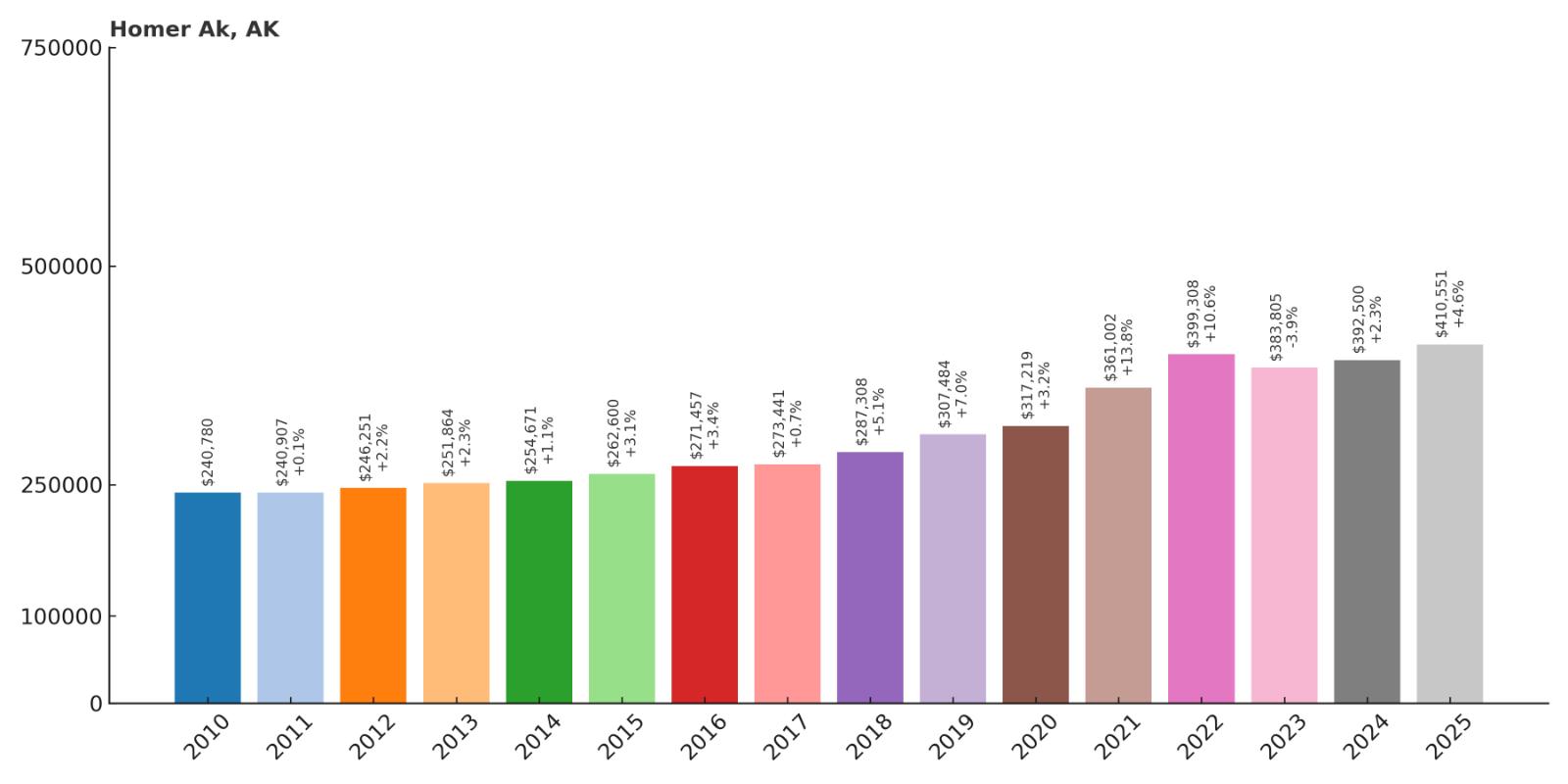
- 2010: $240,780
- 2011: $240,907
- 2012: $246,251
- 2013: $251,864
- 2014: $254,671
- 2015: $262,600
- 2016: $271,457
- 2017: $273,441
- 2018: $287,308
- 2019: $307,484
- 2020: $317,219
- 2021: $361,002
- 2022: $399,308
- 2023: $383,805
- 2024: $392,500
- 2025: $410,551
Homer has demonstrated strong appreciation over 15 years, with home values rising from around $241,000 to over $410,000. The community maintained steady growth through the 2010s before experiencing dramatic acceleration from 2020-2022, adding over $82,000 in median value. After a brief dip in 2023, values have continued climbing to reach new record highs.
Why Homer?

Why are people willing to pay so much to live here? What’s special about it?
Homer offers the perfect combination of small-town charm and sophisticated amenities as the “Halibut Fishing Capital of the World” with a thriving arts community. The city provides stunning views across Kachemak Bay to snow-capped mountains while maintaining excellent restaurants, galleries, and cultural events. Residents enjoy world-class fishing and outdoor recreation alongside a vibrant year-round cultural scene that attracts visitors and artists from around the globe.
The community features the famous Homer Spit, a 4.5-mile sand bar extending into Kachemak Bay that serves as both a working harbor and tourist destination. Properties range from bluff-top homes with panoramic bay views to spit-front locations with direct water access. The combination of natural beauty, recreational opportunities, and cultural sophistication creates exceptional appeal for retirees, artists, and outdoor enthusiasts.
How Homer Rose to Prominence
Homer was founded in the 1890s by Homer Pennock, a gold prospector who established a trading post and coal mining operation along the shores of Kachemak Bay. The area’s excellent natural harbor and abundant coal deposits attracted early settlers, though the community remained small for several decades. The unique Homer Spit provided crucial protection for boats and became the foundation for the town’s maritime economy.
The community’s transformation began in the 1950s and 1960s when improved road connections and the growth of sport fishing brought tourists and new residents seeking the area’s exceptional recreational opportunities. Homer developed its reputation as an arts community in the 1970s and 1980s, attracting painters, writers, and crafters drawn by the stunning scenery and supportive creative environment. Modern Homer balances its roles as a fishing port, tourist destination, and arts community, creating a unique cultural blend that attracts visitors and residents from around the world.
3 Interesting Tidbits
1. The Homer Spit – This natural 4.5-mile sand bar extending into Kachemak Bay was formed by glacial action and serves as both a working harbor and one of Alaska’s most distinctive geographic features.
2. Halibut Capital – Homer hosts the annual Halibut Derby where the largest fish caught can weigh over 400 pounds, with prize money reaching into the tens of thousands of dollars.
3. Arts Haven – The city features more artists per capita than almost any other Alaska community, with numerous galleries, studios, and cultural events throughout the year.
9. Wasilla – 70% Home Price Increase Since 2010
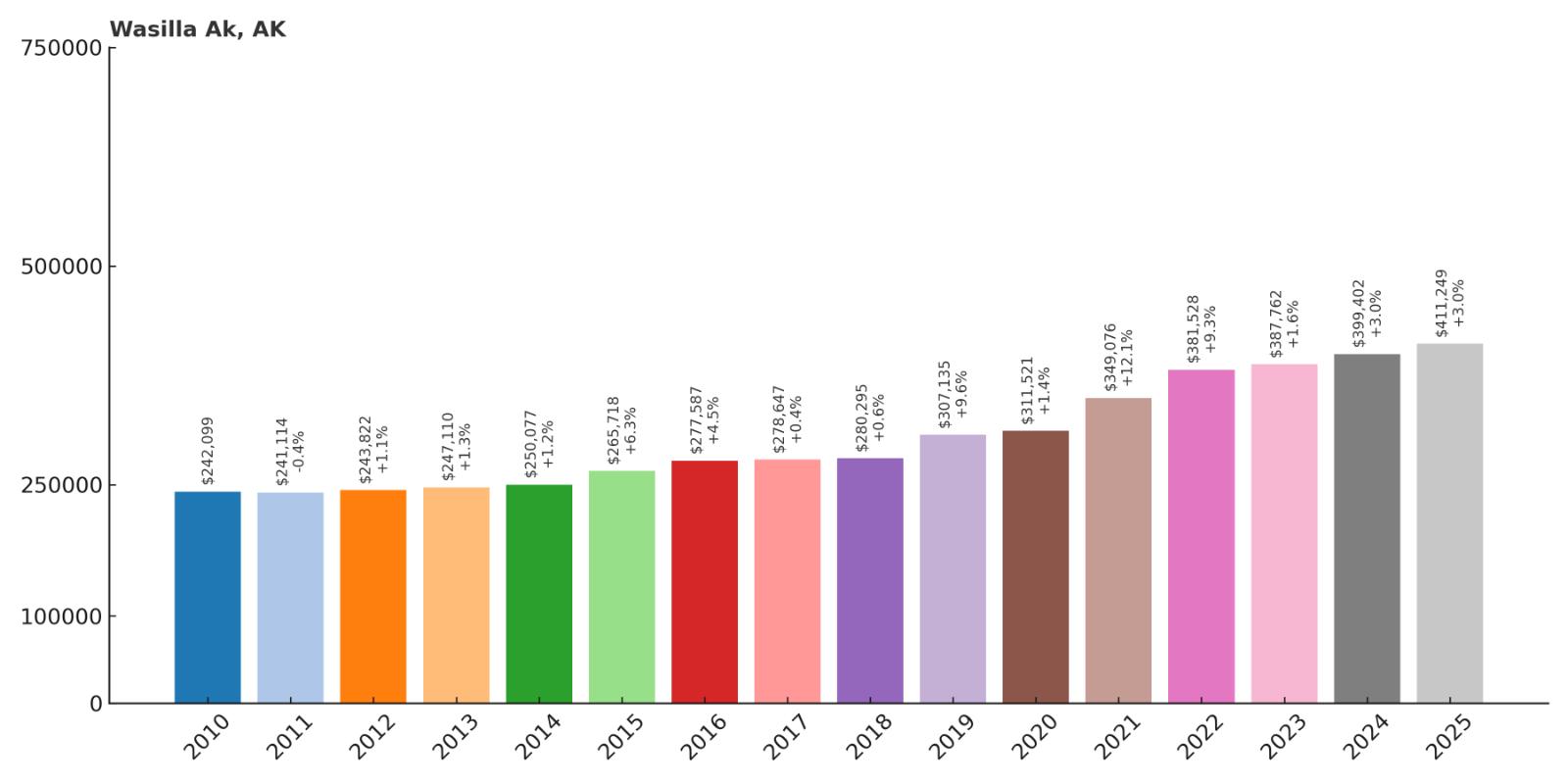
- 2010: $242,099
- 2011: $241,114
- 2012: $243,822
- 2013: $247,110
- 2014: $250,077
- 2015: $265,718
- 2016: $277,587
- 2017: $278,647
- 2018: $280,295
- 2019: $307,135
- 2020: $311,521
- 2021: $349,076
- 2022: $381,528
- 2023: $387,762
- 2024: $399,402
- 2025: $411,249
Wasilla has achieved substantial appreciation over 15 years, with home values rising from around $242,000 to over $411,000. The community showed modest growth through the mid-2010s before accelerating dramatically from 2019 onward, adding over $104,000 in median value. Growth has continued consistently through 2025, with values reaching new record highs.
Why Wasilla?

Why are people willing to pay so much to live here? What’s special about it?
Wasilla serves as the fastest-growing community in Alaska’s Matanuska-Susitna Valley, offering suburban amenities with easy access to both Anchorage employment and world-class outdoor recreation. The city provides comprehensive services, excellent schools, and modern infrastructure while maintaining the Alaska lifestyle that attracts families and outdoor enthusiasts. Residents enjoy larger lots and newer homes at prices below those found in Anchorage.
The community combines small-town character with big-city conveniences, featuring shopping centers, restaurants, and entertainment options alongside easy access to lakes, mountains, and wilderness areas. Properties often feature custom homes on multi-acre lots with mountain views and outdoor recreation access. The balance of affordability, amenities, and outdoor lifestyle creates strong appeal for families and commuters.
How Wasilla Rose to Prominence
Wasilla began as a railroad station on the Alaska Railroad in the 1910s, serving as a supply point for area homesteaders and miners. The community was named after Chief Wasilla, a local Dena’ina Athabascan leader who helped early settlers navigate the area’s geography and resources. For decades, Wasilla remained a small agricultural and supply center supporting valley farms and seasonal activities.
The community’s transformation began in the 1970s and accelerated through the 1980s and 1990s as improved highways made commuting to Anchorage practical for valley residents. Wasilla incorporated as a city in 1974 and began developing modern infrastructure to support rapid residential and commercial growth. The area gained national attention when former mayor Sarah Palin became governor of Alaska and later the Republican vice presidential nominee, putting this once-small town on the national map.
3 Interesting Tidbits
1. Iditarod Restart – Wasilla serves as the ceremonial restart point for the famous Iditarod dog sled race, attracting thousands of visitors each March for the event kickoff.
2. Valley Growth Engine – The city has been one of Alaska’s fastest-growing communities for over two decades, with population increases far exceeding the state average.
3. Lake Country – Wasilla sits among dozens of lakes that provide excellent fishing, boating, and recreational opportunities, earning the area the nickname “Alaska’s Lake Country.”
8. Palmer – 72% Home Price Increase Since 2010
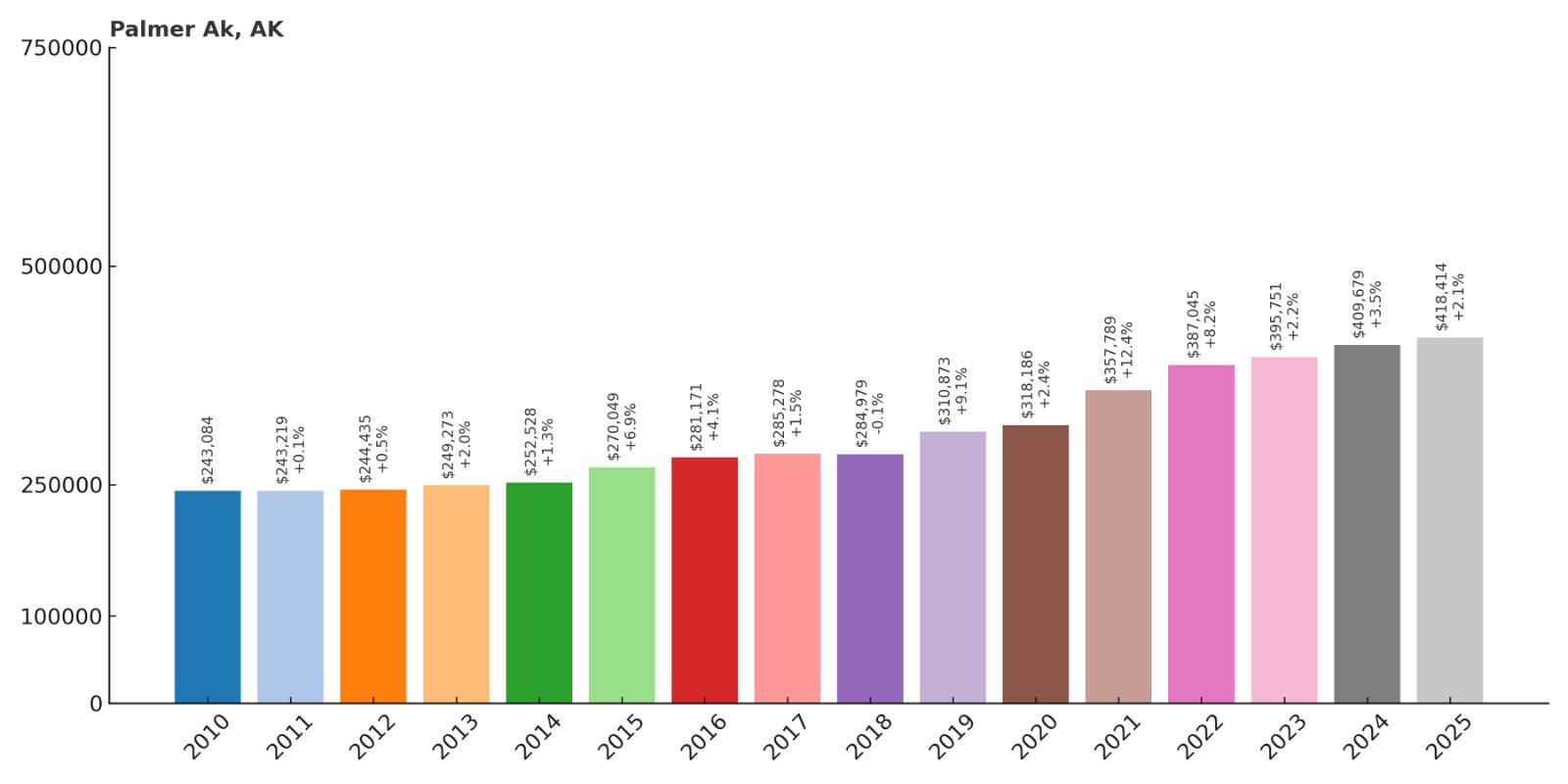
- 2010: $243,084
- 2011: $243,219
- 2012: $244,435
- 2013: $249,273
- 2014: $252,528
- 2015: $270,049
- 2016: $281,171
- 2017: $285,278
- 2018: $284,979
- 2019: $310,873
- 2020: $318,186
- 2021: $357,789
- 2022: $387,045
- 2023: $395,751
- 2024: $409,679
- 2025: $418,414
Palmer has demonstrated strong appreciation over 15 years, with home values rising from around $243,000 to over $418,000. The community maintained modest growth through the mid-2010s before experiencing significant acceleration from 2019 onward, adding over $107,000 in median value. Growth has continued steadily through 2025, with values reaching new record highs.
Why Palmer?

Why are people willing to pay so much to live here? What’s special about it?
Palmer combines Alaska’s agricultural heritage with modern suburban amenities as the heart of the Matanuska-Susitna Valley’s farming region. The city offers small-town charm with excellent schools, services, and community events while providing easy access to both Anchorage employment and outdoor recreation. Residents enjoy the unique experience of living in Alaska’s primary agricultural area with stunning mountain views and rural character.
The community features historic downtown charm alongside modern residential developments, with many properties offering views of Pioneer Peak and the surrounding Chugach Mountains. Palmer hosts the famous Alaska State Fair each summer, drawing visitors from across the state to celebrate Alaska’s agricultural achievements. The combination of agricultural heritage, scenic beauty, and small-town atmosphere creates strong appeal for families and those seeking authentic Alaska community living.
How Palmer Rose to Prominence
Palmer was established in 1935 as part of President Franklin D. Roosevelt’s New Deal program, when 203 farming families from the Depression-hit Midwest were relocated to the Matanuska Valley to establish an agricultural colony. The community was named after George Palmer, a pioneer prospector and trader who explored the area in the early 1900s. The colonists faced enormous challenges adapting to Alaska’s short growing season and harsh climate.
Despite initial hardships, the colony succeeded in establishing Alaska’s most productive agricultural region, with Palmer serving as the commercial and service center for valley farms. The area became famous for producing giant vegetables, including record-setting cabbages weighing over 100 pounds. Modern Palmer has evolved beyond its agricultural roots while maintaining its farming heritage, becoming a thriving suburban community that celebrates its unique history as one of America’s most successful planned agricultural colonies.
3 Interesting Tidbits
1. Giant Vegetables – Palmer’s long summer days and fertile soil produce world-record vegetables, including 138-pound cabbages and 2,000-pound pumpkins displayed at the annual Alaska State Fair.
2. Colony Heritage – The city maintains several buildings from the original 1935 Matanuska Colony, including the historic Palmer Depot which now serves as a museum and visitor center.
3. Musk Ox Farm – Palmer houses the Musk Ox Farm, the only domestic musk ox operation in the world, where these prehistoric animals are raised for their ultra-soft qiviut fiber.
7. Kodiak – 79% Home Price Increase Since 2010

- 2010: $249,729
- 2011: $268,412
- 2012: $279,284
- 2013: $287,188
- 2014: $299,106
- 2015: $307,796
- 2016: $307,982
- 2017: $319,855
- 2018: $332,028
- 2019: $364,338
- 2020: $378,388
- 2021: $410,788
- 2022: $456,305
- 2023: $425,893
- 2024: $407,529
- 2025: $446,402
Kodiak has achieved impressive appreciation over 15 years, with home values rising from around $250,000 to over $446,000. The community showed consistent growth through the 2010s before experiencing dramatic acceleration from 2019-2022, adding over $92,000 in median value. After fluctuations in 2023-2024, values have surged strongly in 2025 to approach previous peaks.
Why Kodiak?

Why are people willing to pay so much to live here? What’s special about it?
Kodiak serves as one of America’s most important fishing ports while offering unique island living with access to world-class outdoor recreation and wildlife viewing. The city provides stable, high-paying employment in commercial fishing and seafood processing while maintaining small-town character and spectacular natural beauty. Residents enjoy exceptional fishing, hunting, and bear viewing opportunities alongside modern amenities and services.
The community combines working waterfront atmosphere with stunning coastal scenery, featuring properties with harbor views and easy access to pristine wilderness areas. Kodiak Island’s isolation creates a tight-knit community atmosphere while the fishing industry provides economic stability unusual in rural Alaska. The balance of economic opportunity, natural beauty, and authentic Alaska lifestyle creates strong appeal for those seeking both career success and outdoor adventure.
How Kodiak Rose to Prominence
Kodiak has been continuously inhabited for over 7,000 years, originally by Alutiiq people who developed sophisticated maritime cultures based on ocean resources. Russian fur traders established the first European settlement in 1792, making Kodiak the first capital of Russian America. The community served as the headquarters for Russian fur trading operations throughout Alaska and the Pacific Northwest.
American development began after the 1867 Alaska Purchase, with the fishing industry gradually replacing fur trading as the economic foundation. The establishment of major seafood processing facilities in the mid-20th century transformed Kodiak into one of America’s most productive fishing ports. Modern Kodiak processes hundreds of millions of pounds of seafood annually while serving as the gateway to Kodiak National Wildlife Refuge, home to the famous Kodiak brown bears.
3 Interesting Tidbits
1. Fishing Powerhouse – Kodiak consistently ranks as one of America’s top fishing ports by both volume and value, processing over 600 million pounds of seafood annually.
2. Bear Island – Kodiak Island is home to the world’s largest brown bears, with some male Kodiak bears weighing over 1,500 pounds and standing 10 feet tall on their hind legs.
3. Russian Heritage – The Kodiak Historical Museum houses extensive Russian artifacts and the Holy Resurrection Russian Orthodox Church, reflecting the area’s significance as Russia’s first Alaskan capital.
6. Juneau – 61% Home Price Increase Since 2010
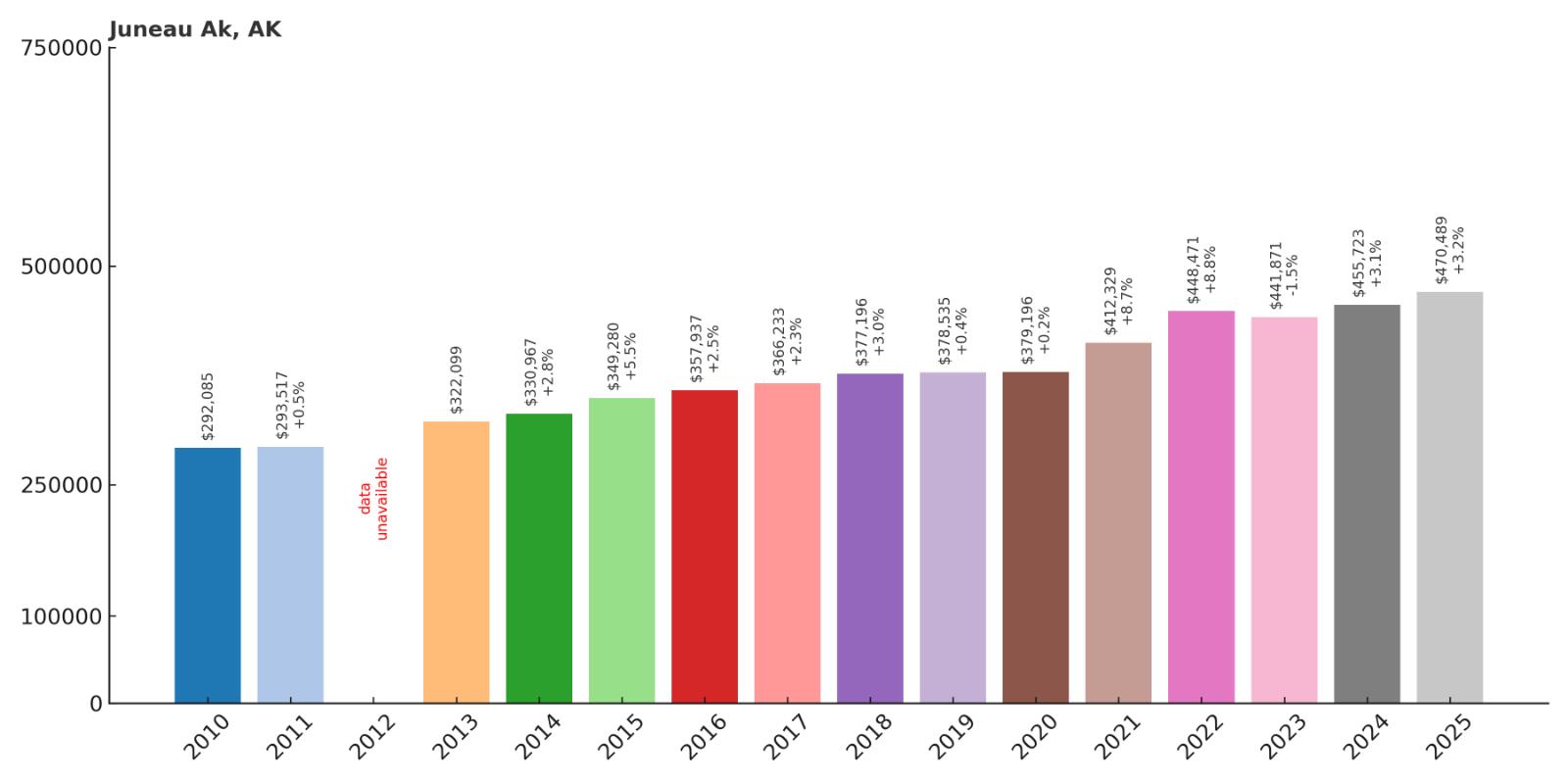
- 2010: $292,085
- 2011: $293,517
- 2012: N/A
- 2013: $322,099
- 2014: $330,967
- 2015: $349,280
- 2016: $357,937
- 2017: $366,233
- 2018: $377,196
- 2019: $378,535
- 2020: $379,196
- 2021: $412,329
- 2022: $448,471
- 2023: $441,871
- 2024: $455,723
- 2025: $470,489
Juneau has demonstrated solid appreciation over 15 years, with home values rising from around $292,000 to over $470,000. The capital city maintained steady growth through the 2010s before experiencing significant acceleration from 2020-2022, adding over $69,000 in median value. After a brief dip in 2023, values have continued climbing strongly to reach new record highs.
Why Juneau?

Why are people willing to pay so much to live here? What’s special about it?
Juneau serves as Alaska’s capital city, providing stable government employment and comprehensive urban services in one of America’s most scenic settings. The city offers excellent schools, healthcare, and cultural amenities while surrounded by mountains, glaciers, and pristine wilderness areas. Residents enjoy the benefits of living in the seat of state government while maintaining access to world-class outdoor recreation and authentic Southeast Alaska experiences.
The community features dramatic topography with homes built on hillsides overlooking the Gastineau Channel and surrounding mountains, creating some of Alaska’s most spectacular residential settings. Properties range from downtown condominiums to custom homes with glacier views. The combination of economic stability, cultural amenities, and natural beauty creates exceptional appeal for government workers, professionals, and those seeking sophisticated urban Alaska living.
How Juneau Rose to Prominence
Juneau was founded in 1880 following the discovery of gold by prospectors Joe Juneau and Richard Harris, guided by Tlingit Chief Kowee who showed them the location of rich gold deposits. The town quickly became the center of a major gold mining district, with large-scale operations including the famous Alaska-Juneau Mine. The community was originally called Harrisburg but was renamed Juneau after one of its founders.
Juneau became Alaska’s territorial capital in 1906, transferring government operations from Sitka due to its more central location and economic importance. The city survived the end of gold mining by reinventing itself around government, fishing, and eventually tourism. When Alaska achieved statehood in 1959, Juneau remained the capital despite several attempts to move government operations to larger cities, cementing its role as Alaska’s political and administrative center.
3 Interesting Tidbits
1. Accessible Only by Air or Sea – Juneau is the only state capital in America with no road connections to other communities, making it accessible only by airplane or boat.
2. Mendenhall Glacier – The city features the spectacular Mendenhall Glacier, one of the world’s most accessible glaciers, located just 12 miles from downtown.
3. Government Hub – As Alaska’s capital, Juneau houses all state government operations and employs thousands of residents in stable, well-paying government positions.
5. Eagle River – 31% Home Price Increase Since 2016
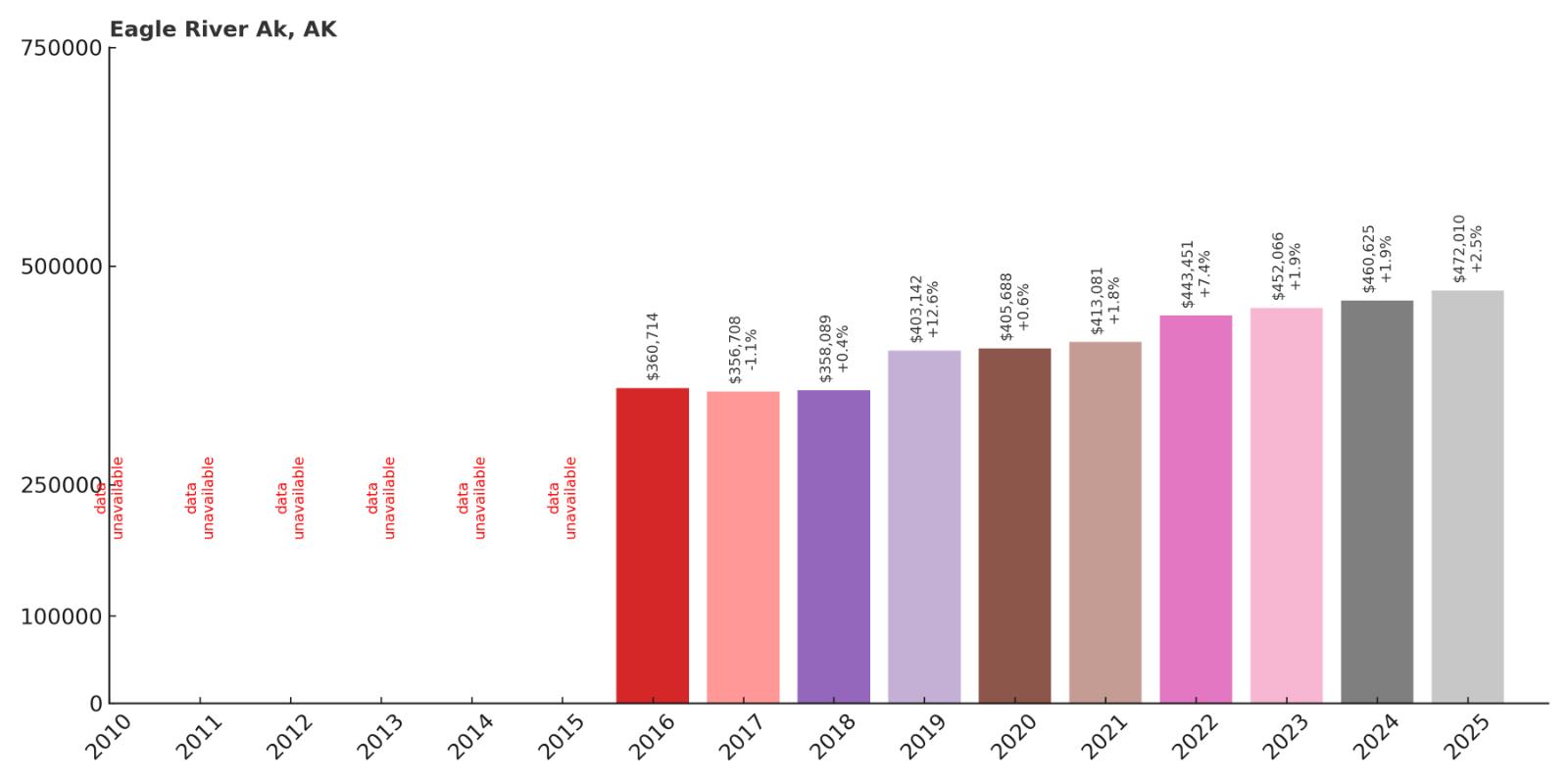
- 2010: N/A
- 2011: N/A
- 2012: N/A
- 2013: N/A
- 2014: N/A
- 2015: N/A
- 2016: $360,714
- 2017: $356,708
- 2018: $358,089
- 2019: $403,142
- 2020: $405,688
- 2021: $413,081
- 2022: $443,451
- 2023: $452,066
- 2024: $460,625
- 2025: $472,010
Eagle River has shown steady appreciation since 2016, with home values rising from around $361,000 to over $472,000. The community experienced modest growth through 2018 before accelerating significantly from 2019 onward, adding over $111,000 in median value. Growth has continued consistently through 2025, with values reaching new record highs.
Why Eagle River?

Why are people willing to pay so much to live here? What’s special about it?
Eagle River offers upscale suburban living with mountain views and outdoor recreation access while maintaining easy commuting distance to Anchorage employment and services. The community provides excellent schools, family-friendly neighborhoods, and larger lot sizes than typically found in Anchorage proper. Residents enjoy hiking trails, parks, and wilderness access literally at their doorsteps while living in one of Alaska’s most desirable residential areas.
The area features predominantly newer, custom-built homes designed to take advantage of the spectacular Chugach Mountain setting and Eagle River valley views. Properties often include large lots with privacy and space for outdoor activities while staying connected to urban amenities. The combination of natural beauty, excellent schools, and proximity to Anchorage creates exceptional appeal for affluent families and professionals.
How Eagle River Rose to Prominence
Eagle River began as a small railroad settlement in the early 1900s, serving travelers and workers along the Alaska Railroad route between Anchorage and the interior. The area remained largely undeveloped for decades due to its distance from Anchorage and limited road access. Early residents were primarily homesteaders attracted by the scenic valley setting and opportunities for subsistence activities.
Development accelerated dramatically in the 1970s and 1980s as improved highways made commuting to Anchorage practical and the area’s natural beauty attracted affluent residents seeking larger lots and mountain views. Eagle River developed as one of Alaska’s premier suburban communities, with careful planning that preserved natural areas while providing modern infrastructure. The community has maintained its reputation as Anchorage’s most desirable suburb, attracting successful professionals and families who value both convenience and natural beauty.
3 Interesting Tidbits
1. Bear Country – Eagle River residents regularly encounter black and brown bears in their neighborhoods, with the area serving as important wildlife habitat corridors.
2. Hiking Paradise – The community provides direct access to dozens of hiking trails in Chugach State Park, including popular routes to Eagle Peak and Symphony Lake.
3. Planned Community – Eagle River represents one of Alaska’s most successful examples of planned suburban development, balancing growth with environmental preservation.
4. Cooper Landing – 91% Home Price Increase Since 2012
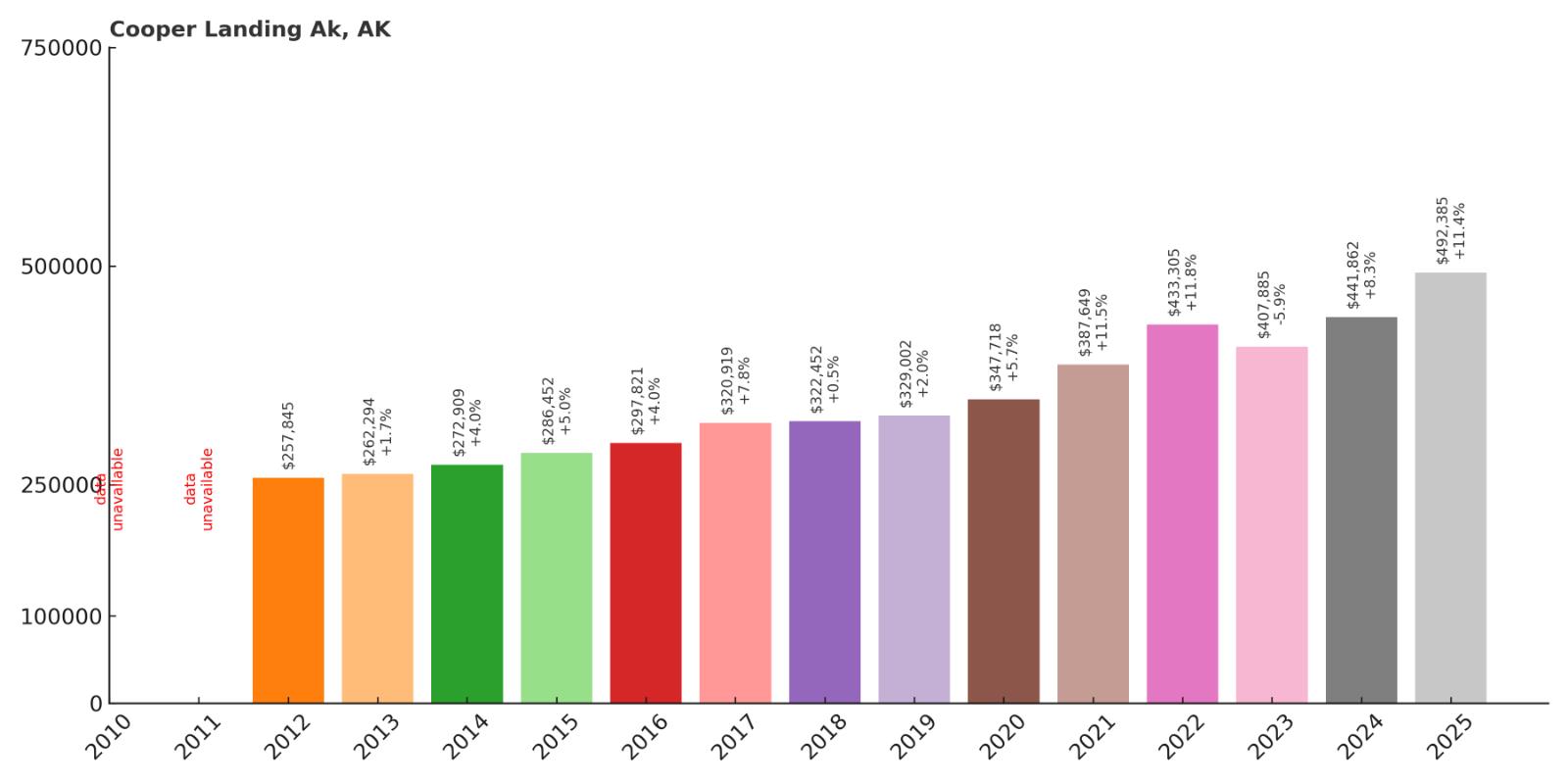
- 2010: N/A
- 2011: N/A
- 2012: $257,845
- 2013: $262,294
- 2014: $272,909
- 2015: $286,452
- 2016: $297,821
- 2017: $320,919
- 2018: $322,452
- 2019: $329,002
- 2020: $347,718
- 2021: $387,649
- 2022: $433,305
- 2023: $407,885
- 2024: $441,862
- 2025: $492,385
Cooper Landing has achieved dramatic appreciation since 2012, with home values nearly doubling from around $258,000 to over $492,000. The community showed steady growth through the 2010s before experiencing significant acceleration from 2020-2022, adding over $85,000 in median value. After a dip in 2023, values have surged strongly to reach new record highs in 2025.
Why Cooper Landing?

Why are people willing to pay so much to live here? What’s special about it?
Cooper Landing represents the pinnacle of Alaska fishing destinations, situated at the confluence of the Kenai and Russian rivers where world-record salmon are caught annually. The community offers unparalleled access to wilderness recreation while maintaining essential services and a strong sense of community among outdoor enthusiasts. Residents enjoy living in one of Alaska’s most scenic locations with direct access to activities that visitors travel thousands of miles to experience.
The area features properties with riverfront access and mountain views that provide the ultimate Alaska lifestyle for fishing and outdoor recreation enthusiasts. Limited development and protected wilderness areas ensure that Cooper Landing maintains its pristine character while creating scarcity that drives premium pricing. The combination of world-class recreation access, natural beauty, and authentic Alaska character creates exceptional appeal for those seeking the ultimate outdoor lifestyle.
How Cooper Landing Rose to Prominence
Cooper Landing was established in the 1880s as a supply point for miners heading to goldfields in the upper Kenai Peninsula and interior Alaska. The community was named after Joseph Cooper, a prospector who established one of the first permanent settlements at the strategic location where the Russian River joins the Kenai River. Early residents combined mining activities with guiding services for hunters and fishermen attracted by the area’s abundant wildlife.
The community’s transformation from mining camp to fishing destination began in the mid-20th century as sport fishing grew in popularity and road access improved. Cooper Landing became renowned for its exceptional salmon fishing, particularly on the Russian River, attracting anglers from around the world. Modern Cooper Landing has evolved into Alaska’s premier fishing community, balancing tourism with residential development while maintaining its character as an authentic wilderness destination.
3 Interesting Tidbits
1. Russian River Fishing – Cooper Landing provides access to the famous Russian River, where up to 3,000 anglers per day fish for sockeye salmon during peak season runs.
2. Kenai Princess Lodge – The community hosts one of Alaska’s premier wilderness lodges, attracting visitors who come specifically for the world-class fishing and scenic beauty.
3. Recreation Gateway – Cooper Landing serves as the gateway to the Chugach National Forest and provides access to countless hiking, fishing, and wildlife viewing opportunities.
3. Chugiak – 36% Home Price Increase Since 2016
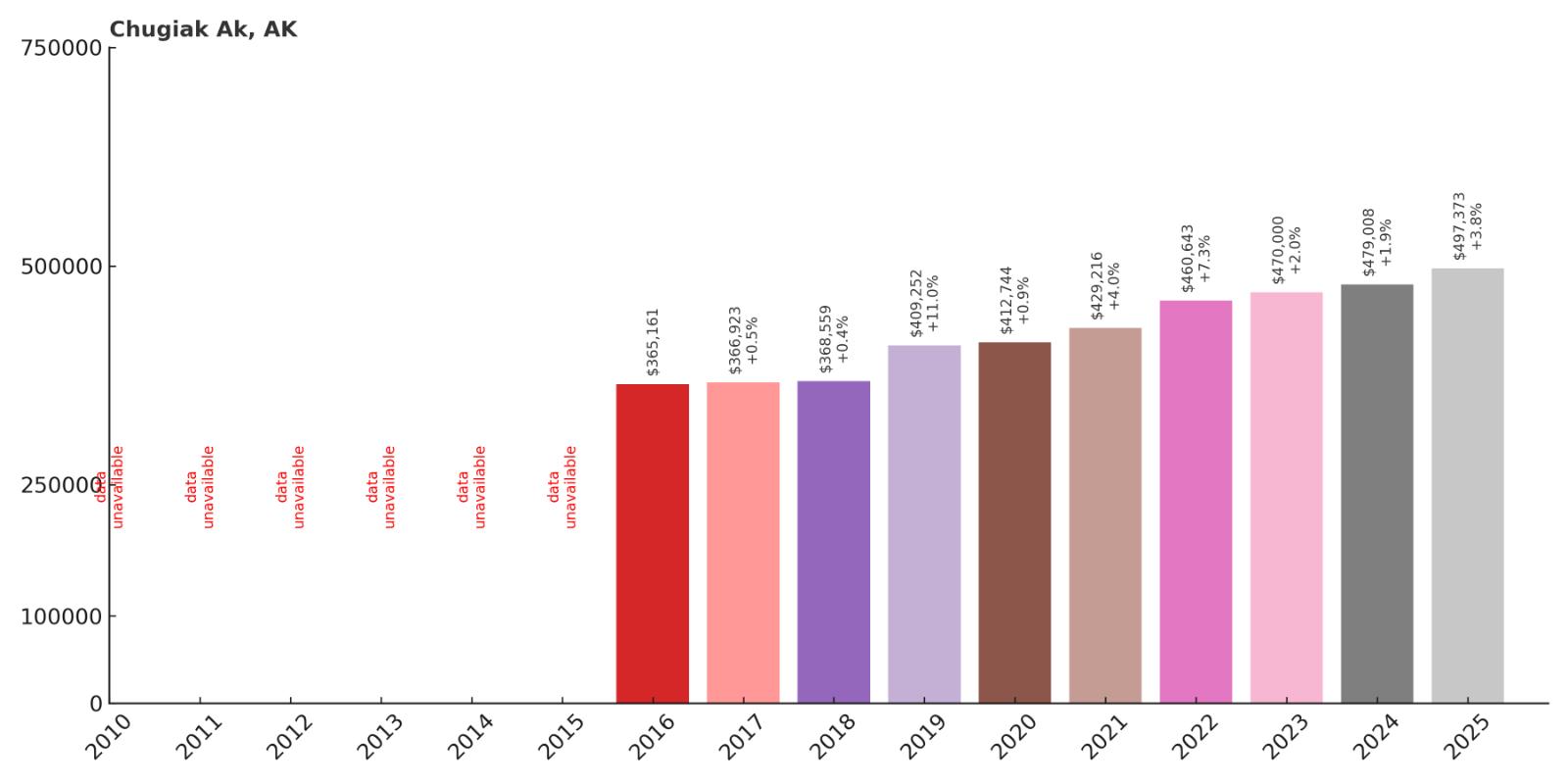
- 2010: N/A
- 2011: N/A
- 2012: N/A
- 2013: N/A
- 2014: N/A
- 2015: N/A
- 2016: $365,161
- 2017: $366,923
- 2018: $368,559
- 2019: $409,252
- 2020: $412,744
- 2021: $429,216
- 2022: $460,643
- 2023: $470,000
- 2024: $479,008
- 2025: $497,373
Chugiak has demonstrated strong appreciation since 2016, with home values rising from around $365,000 to nearly $497,000. The community showed modest growth through 2018 before experiencing steady acceleration from 2019 onward, adding over $132,000 in median value. Growth has continued consistently through 2025, with values reaching new record highs.
Why Chugiak?

Why are people willing to pay so much to live here? What’s special about it?
Chugiak offers rural estate living with mountain views and large lots while maintaining reasonable commuting access to Anchorage employment and services. The community provides the ultimate Alaska residential experience with custom homes on multi-acre properties surrounded by wilderness and wildlife. Residents enjoy privacy, space, and outdoor recreation access while living in one of the state’s most exclusive residential areas.
The area features predominantly high-end custom homes designed to take advantage of spectacular mountain and valley views while providing the space and privacy that attracts affluent buyers. Properties often include extensive grounds suitable for horses, outdoor recreation, and wildlife viewing. The combination of exclusivity, natural beauty, and proximity to Anchorage creates exceptional appeal for successful professionals and those seeking luxury Alaska living.
How Chugiak Rose to Prominence
Chugiak began as a railroad station and small settlement along the Alaska Railroad in the early 1900s, serving as a supply point for area homesteaders and seasonal workers. The name “Chugiak” comes from the Dena’ina Athabascan word meaning “place of many places,” referring to the area’s diverse landscape of mountains, valleys, and water features. Early development was limited due to challenging access and the need for substantial infrastructure investment.
The community’s transformation into an exclusive residential area began in the 1970s and 1980s as successful Anchorage professionals sought larger properties and mountain views while maintaining reasonable commuting distance to the city. Chugiak developed as one of Alaska’s premier residential communities, with careful planning that preserved natural areas while accommodating luxury home development. Modern Chugiak represents the pinnacle of Alaska residential living, combining rural estate character with urban convenience.
3 Interesting Tidbits
1. Estate Living – Chugiak features some of Alaska’s largest residential properties, with many homes situated on 5-40 acre lots that provide ultimate privacy and space.
2. Mountain Views – The community offers some of the most spectacular mountain views in Alaska, with homes positioned to maximize vistas of the Chugach Mountains and surrounding peaks.
3. Wildlife Habitat – Chugiak properties regularly host moose, bears, and other wildlife, providing residents daily opportunities to observe Alaska’s magnificent fauna.
2. Kachemak City – 74% Home Price Increase Since 2010
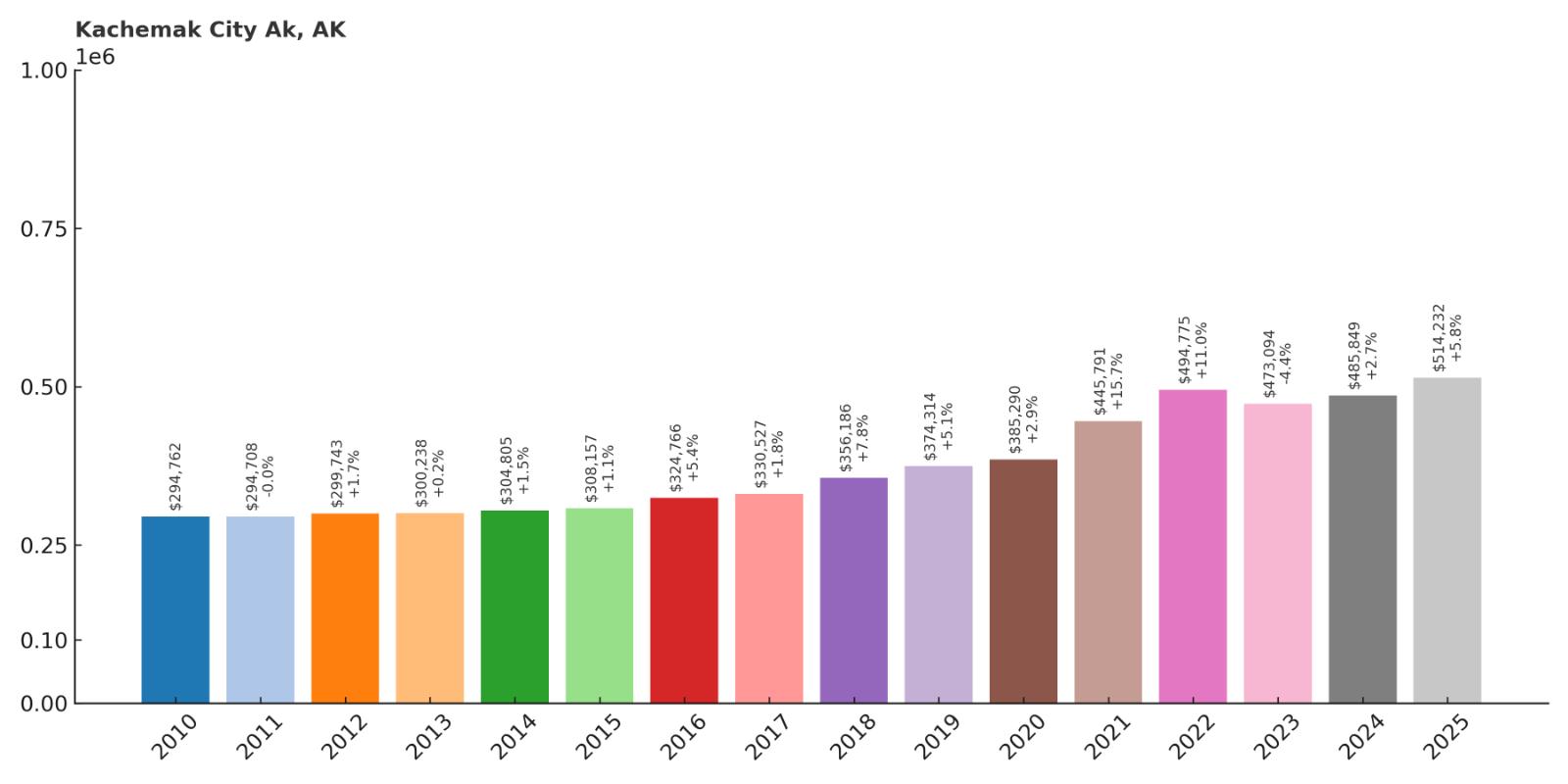
- 2010: $294,762
- 2011: $294,708
- 2012: $299,743
- 2013: $300,238
- 2014: $304,805
- 2015: $308,157
- 2016: $324,766
- 2017: $330,527
- 2018: $356,186
- 2019: $374,314
- 2020: $385,290
- 2021: $445,791
- 2022: $494,775
- 2023: $473,094
- 2024: $485,849
- 2025: $514,232
Kachemak City has achieved substantial appreciation over 15 years, with home values rising from around $295,000 to over $514,000. The community maintained steady growth through the 2010s before experiencing dramatic acceleration from 2020-2022, adding over $109,000 in median value. After modest fluctuations, values have continued climbing strongly to reach new record highs in 2025.
Why Kachemak City?

Why are people willing to pay so much to live here? What’s special about it?
Kachemak City offers exclusive waterfront living with panoramic views across Kachemak Bay to snow-capped mountains and glaciers. The community provides the ultimate Alaska coastal lifestyle with direct water access, world-class fishing, and pristine wilderness at residents’ doorsteps. Properties feature custom homes designed to maximize the spectacular setting while providing luxury amenities and privacy that create an unparalleled living experience.
The area represents one of Alaska’s most exclusive residential enclaves, with limited development preserving the pristine character while creating scarcity that drives premium pricing. Residents enjoy direct access to exceptional outdoor recreation including fishing, boating, and wildlife viewing while living in custom homes with unobstructed bay views. The combination of natural beauty, exclusivity, and waterfront access creates exceptional appeal for affluent buyers seeking the ultimate Alaska lifestyle.
How Kachemak City Rose to Prominence
Kachemak City developed as an exclusive residential community beginning in the 1960s and 1970s when affluent individuals began purchasing waterfront properties along Kachemak Bay’s pristine shoreline. The area was originally used by Native peoples for seasonal fishing and hunting camps, taking advantage of the bay’s rich marine resources and protected waters. Early development was carefully planned to preserve the natural environment while providing luxury residential opportunities.
The community grew slowly and deliberately, with property owners committed to maintaining the area’s pristine character and exclusive atmosphere. Strict development standards and environmental protections have preserved Kachemak City’s reputation as one of Alaska’s most desirable residential areas. Modern Kachemak City represents the pinnacle of Alaska waterfront living, combining luxury amenities with uncompromised natural beauty and environmental stewardship.
3 Interesting Tidbits
1. Waterfront Paradise – Nearly every property in Kachemak City features direct waterfront access with private beaches and stunning views across Kachemak Bay.
2. Exclusive Development – The community maintains strict development standards that preserve its character while ensuring all homes meet luxury standards and environmental requirements.
3. Marine Sanctuary – Kachemak Bay provides some of Alaska’s richest marine environments, with residents enjoying excellent fishing, clamming, and wildlife viewing opportunities.
1. Sitka – 23% Home Price Increase Since 2016
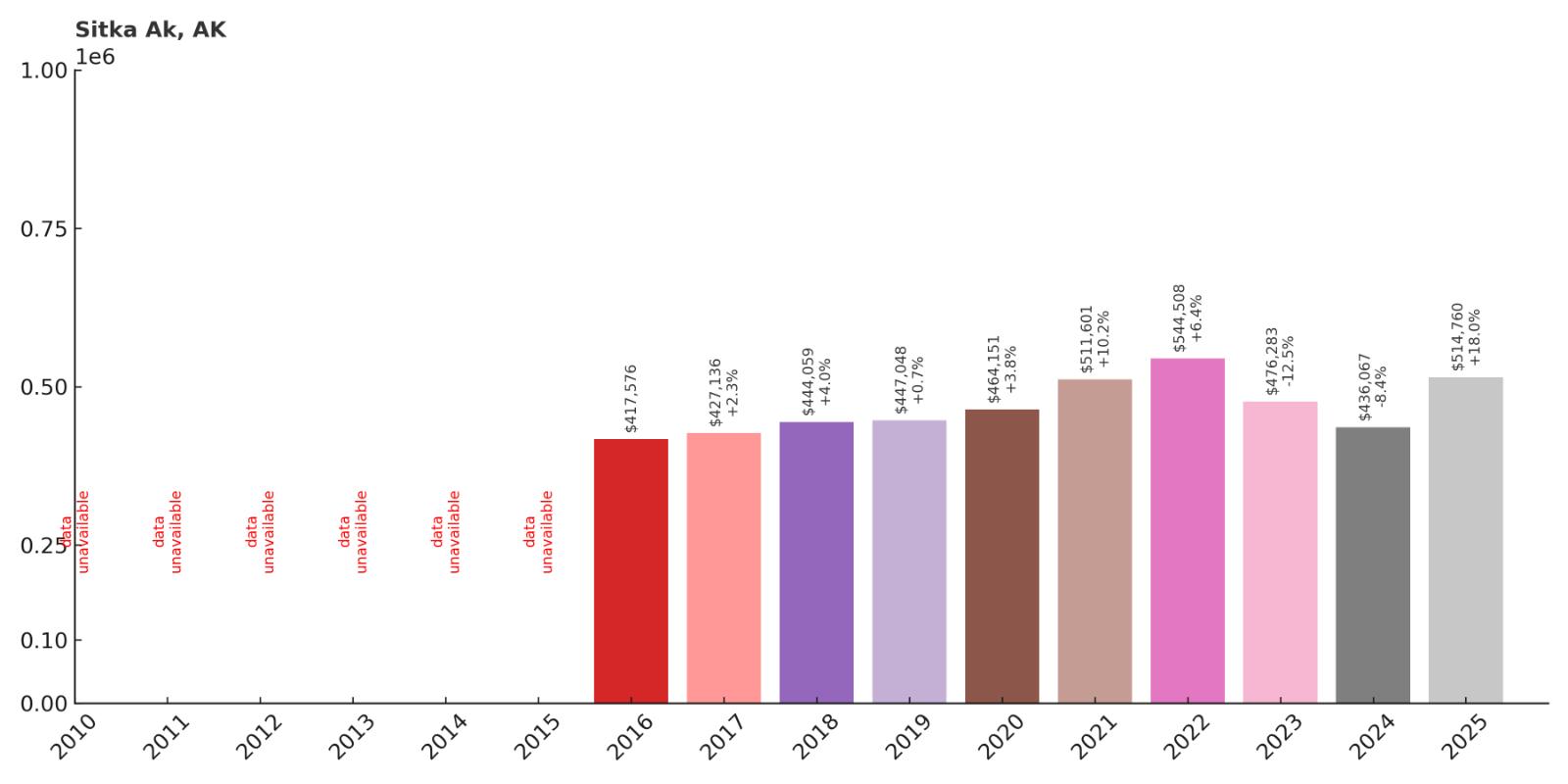
- 2010: N/A
- 2011: N/A
- 2012: N/A
- 2013: N/A
- 2014: N/A
- 2015: N/A
- 2016: $417,576
- 2017: $427,136
- 2018: $444,059
- 2019: $447,048
- 2020: $464,151
- 2021: $511,601
- 2022: $544,508
- 2023: $476,283
- 2024: $436,067
- 2025: $514,760
Sitka has shown moderate but consistent growth since 2016, with home values rising from around $418,000 to nearly $515,000. The community experienced steady appreciation through 2022, reaching over $544,000 before experiencing significant volatility in 2023-2024. Values have rebounded strongly in 2025, demonstrating underlying market strength despite recent fluctuations.
Why Sitka?

Why are people willing to pay so much to live here? What’s special about it?
Sitka offers unparalleled cultural richness and natural beauty as one of Alaska’s most historically significant communities with world-class amenities and attractions. The city combines Russian colonial heritage, Native Tlingit culture, and American influences while providing excellent schools, healthcare, and cultural institutions unusual in Southeast Alaska. Residents enjoy living in one of America’s most beautiful settings with access to pristine wilderness, exceptional fishing, and a sophisticated community atmosphere.
The community features a unique blend of historic architecture, cultural attractions, and modern amenities set against the backdrop of Mount Edgecumbe and the Pacific Ocean. Properties range from historic homes in the downtown area to waterfront estates with panoramic ocean views. The combination of cultural significance, natural beauty, and sophisticated amenities creates exceptional appeal for those seeking the ultimate Alaska community experience.
How Sitka Rose to Prominence
Sitka served as the capital of Russian America from 1808 to 1867, making it one of the most historically significant communities on the West Coast. Originally the site of a major Tlingit settlement called Sheet’ká, the area became the center of Russian colonial operations in Alaska and the Pacific Northwest. The community developed sophisticated cultural institutions including schools, libraries, and the first Protestant church in Alaska.
After the Alaska Purchase in 1867, Sitka continued as Alaska’s territorial capital until 1906, maintaining its role as the territory’s most important cultural and administrative center. The community preserved its rich multicultural heritage while developing modern amenities and institutions. Modern Sitka balances its roles as a cultural destination, fishing community, and residential haven, creating one of Alaska’s most sophisticated and desirable places to live.
3 Interesting Tidbits
1. Cultural Capital – Sitka houses more National Historic Landmarks than any other Alaska community, reflecting its significance as the former Russian colonial capital.
2. Mount Edgecumbe – The community sits in the shadow of Mount Edgecumbe, a dormant volcano that creates one of the most recognizable and beautiful backdrops in Alaska.
3. Sitka Sound – The city overlooks Sitka Sound, a protected waterway that provides excellent fishing, boating, and wildlife viewing opportunities while creating stunning residential settings.



